John William Pilbean Goffage MBE ''Chips Rafferty'' of Lovett Bay: Victory in the pacific day 2021
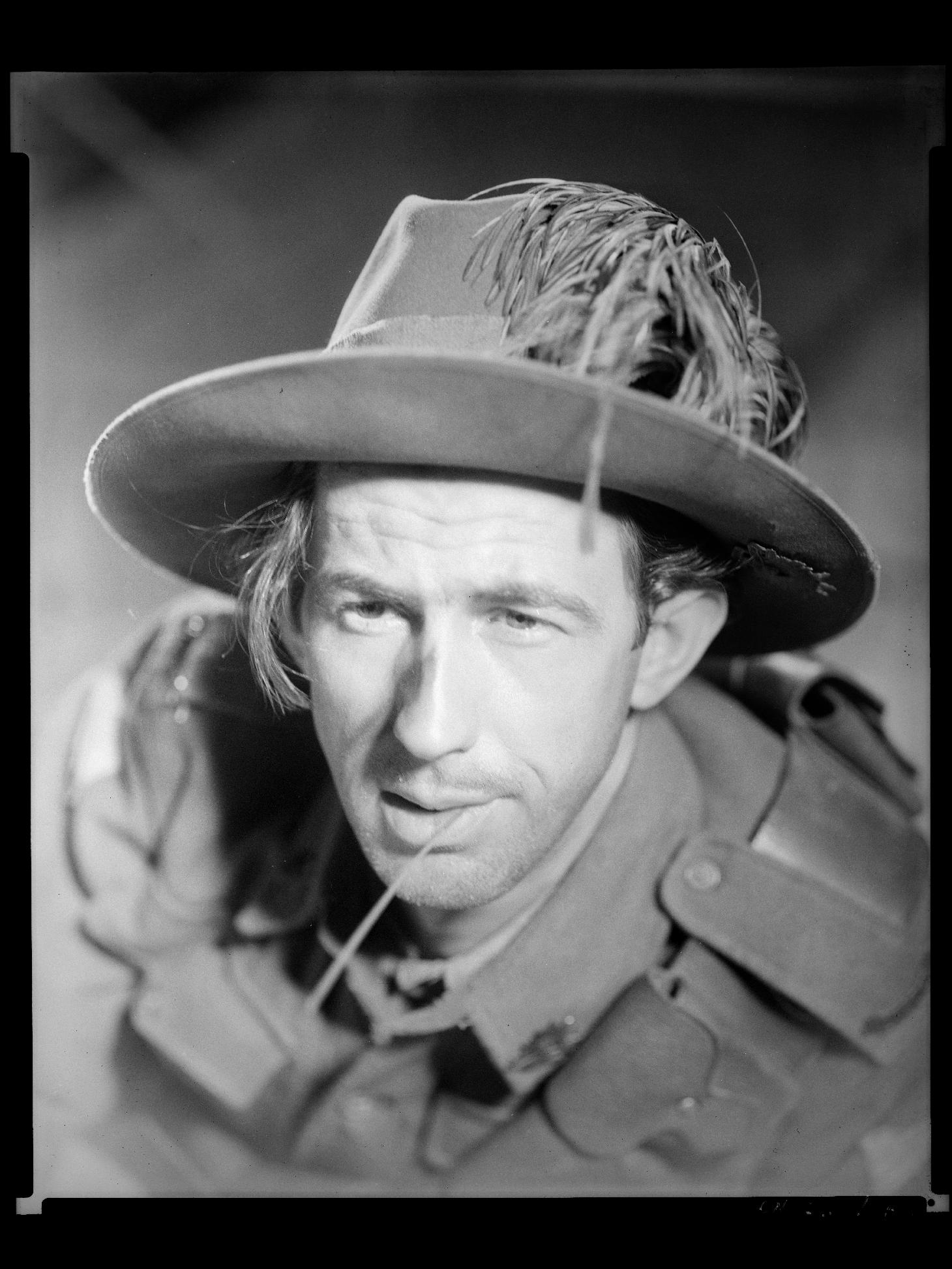
My father was in the Church Point Bushfire brigade as it was then with his great friend Dr Walter Wearn from Scotland Island. I believe John Goffage (Chips Rafferty) was also a member at the time. The Pittwater Online schools articles included Loquat Valley School which I attended between 1954 and 1956 and my father was also a member of the RPA yacht club.
Some time ago, my daughter asked me to write my childhood memories and I included memories of the yacht club and Loquat Valley school. I have just done a quick cut and paste of those sections into the attached document which you may find interesting. I don’t know if any of it is suitable for publication in your online news but I would have no objection to you using it as you see fit.
Thanks for a very interesting publication.
Andrew Amos – May 9, 2016 - From 'Bayview Days: Pittwater in the 1950's', Issue 263, May 2016
Leisure
The sea at Church Point yesterday was almost a turquoise blue, the water had the gentlest ripple and from where we sat we looked across to the home of Dorothea Mackellar, who wrote, a poem for every child to read — My Country. Sitting together in this leisurely moment were three fellows celebrating their birthdays— our own Kenneth Slessor, Chips Rafferty and artist Jim Russell. They've been meeting year after year in strange places but this was the nicest of the lot— a place for a poet, an artist and an actor to dream. CONTACT (1950, March 27). The Sun (Sydney, NSW : 1910 - 1954), p. 1 (LATE FINAL EXTRA). Retrieved from http://nla.gov.au/nla.news-article230167248
The 'Bohemian' and artistic lifeblood of the Elvina Bay - Lovett Bay area that commenced with those who built weekenders and seasonal holiday homes that began in the late 1880's persisted into the 1920's, 1930's, 1940's, 1950's and even unto today. Among those who secured a 'place to fish, daydream and write poetry' was John Goffage, know by his screen name 'Chips' Rafferty, who bought a boatshed on the southern reaches of Lovett Bay with his second wife, Ellen Kathleen 'Quentin' (nee Jameson), in 1947.
'Chips' was the forerunner of characters like 'Crocodile Dundee' while one of the films he starred in, 'The Overlanders' (1946) was a forerunner of such iconic and very similar Australian tales aptly named 'Australia' (2008). Telling Australian stories with an Australian voice, wherein, as many claim, he consistently just 'played' himself - and his 'self' as an unaffected, down to earth, a man who spoke up for others even when that would attract the ire of bigots and who was, in the 1984 words of Michael Pate, with whom he worked in "Forty Thousand Horsemen'', "Sons of Matthew" and "Bitter Springs" - ''He was very thoughtful, very sensitive, very sort of self-possessed, often opinionated, sometimes aggressive lovable old bastard''.
He also, through his service during World War II, was a recipient of the Pacific Star medal. The Pacific Star was a service medal awarded to British and Commonwealth personnel who served in the Pacific between 8 December 1941 and 2 September 1945. The green and yellow lines of the ribbon represent the jungles and beaches of the Pacific islands, while the other colours symbolise the three fighting services: dark blue for the navy, red for the army, and light blue for the air force.
As VP (Victory in the Pacific) Day is celebrated and Service Personnel who lost their lives in this arena Commemorated on August 15th each year, to commemorate Japan's acceptance of the Allied demand for unconditional surrender [made on] 14 August 1945, this 'fisherman of Lovett Bay' leads out today, Sunday August 15th, 2021. The tribute has added significance when you know John William Pilbean Goffage's brother, Francis Campbell Pilbean Goffage, born June 19th 1912 at Adelaide, South Australia, lost his life when the ship his was a POW on, the SS Rakuyō Maru was sunk in the South China Sea on September 12th 1944. He was being transported to Japan to work.
'Frank', as he was known by family members, enlisted in the Second Australian Imperial Force on March 20th, 1941. Posted to the 3rd Reserve Motor Transport Company, General Base Depot, Malaya, he was with the ill-fated 8th Division, and became a prisoner-of-war around February 15th 1942 when Singapore fell to the Japanese Imperial Army.
Prior to that, like his father, brothers and sisters, he had been a keen sportsman with his name appearing in the local paper for winning cycling races:
F. C. Goffage is making a name for himself in the Parramatta-Granville Association's annual tournament. A member of the Parramatta-Central Club Goffage will play in the semi-finals of the B2 singles and the quarter-finals of the C1 and B1 singles. He has lost only one set in all his matches. YOUNG TENNIS STARS NOT TO PLAY (1937, August 25). The Sun (Sydney, NSW : 1910 - 1954), p. 23 (LATE FINAL EXTRA). Retrieved from http://nla.gov.au/nla.news-article231078647
GOFFAGE.—NX71655, Private Francis (Frank) reported missing, presumed dead, September 12, 1944, beloved son of Violet and late John Goffage, brother of John, Joyce, Hazel, Charles. Family Notices (1946, January 19). The Sydney Morning Herald (NSW : 1842 - 1954), p. 30. Retrieved from http://nla.gov.au/nla.news-article27916086
John William Pillbean Goffage was born at Billy Goat Hill near Broken Hill on March 26th, 1909, the eldest son of an emigrant father John William Goffage (born January 1859) and born in Australia mother, Violet Maud Edyith, née Joyce (born circa 1884) - they married March 20th, 1908.
His father was 17 when he emigrated aboard the 'Great Queensland' steamship with his schoolteacher father, also called John, and piano teacher mother, Lucy, to Queensland. The name 'Pilbeam' is of Medieval English origin and is locational, from some 'lost' place in Sussex, deriving from the Old English pre 7th Century 'pil', a pile, or stake, with 'beam', a beam or footbridge (made with stakes). The surname Pilbean was first found in Sussex where they held a family seat as Lords of the Manor. After the Battle of Hastings in 1066, William, Duke of Normandy, having prevailed over King Harold, granted most of Britain to his many victorious Barons. Members of this family also emigrated to Ireland. Alice May Pilbeam was the mother of Violet. She married William Joseph Joyce in 1890 in Victoria. Her husband died late in 1901. The Family members who had this as part of their christened names spelled it 'Pilbean'.
GOFFAGE—JOYCE.—On the 20th March, at Immaculate Conception Church, Glenferrie, John Goffage, of Broken Hill, to Violet Maude Eyidth Joyce, only daughter of Alice and the late William Joyce, late of Kew. Other papers copy. Family Notices (1908, April 4). The Argus (Melbourne, Vic. : 1848 - 1957), p. 11. Retrieved from http://nla.gov.au/nla.news-article10646437
J W Goffage and Violet had five children, John, Joyce Patricia (Goffage) Oglesby, born 1911 in Broken Hill, Francis Campbell Pilbean Goffage, born 1912 in Adelaide, Hazel Maud Pilbean Goffage, born 1914 in Adelaide and Charles Frederick Goffage, born 1919 with the birth registered at Hurstville, Sydney. Charles would become a union winger of renown with Parramatta in his younger days and a career boilermaker who passed away October 4th, 1991.
John's father worked as a silver miner, agent, hotel-keeper as well as holding positions in community service, some of them of a musical strain. In recollections of later years 'Chips' recalled his father was 50 by the time he was born and, although a keen horseman, was clearly too busy earning money for their bread and a roof over their heads to 'play'. After living in several places, Broken Hill, Adelaide, and apparently learning while still young indigenous stories about the land and having a connection with the original peoples of this land - which would persist throughout his life - the growing family headed to Sydney's western suburbs.
They were at Westmead by 1919 where his brother 'Charlie' was born. Recollections by 'Chips' state the first six months was spent 'at the beach' and on the Parramatta river or in orchards, eating fruit, rather than attending school - quite possible as his father was still going back and forth to rural areas at this stage to attend to his 'holdings' as hotels and also electioneering for the National Party. From this time, at least, his passion for the water, for fishing, swimming and other water sports commenced - he was a lifelong surfer.
It was also around this time that his nickname of 'Chips' began, later to be his screen name, according to some sources - others state this name came from Charles Chauvel for Forty Thousand Horsemen (1940) when Chauvel introduced a fresh-faced Chips Rafferty, who modelled his performance in part on the comical digger created by Pat Hanna in Diggers (1931).
. The 'Rafferty' part seems to have evolved from his own incredulous remark about the 'Rafferty's rules' (no rules) that seemed to be part of trying to make films during the late 1930's - a state of affairs that persists if popular legend is to be believed. The 'Chips' nickname story stems from earlier times and goes, in this rendition:
Roundabout
By Brock
ALL the gang had nicknames, excepting Johnny, aged 13, already long, lanky and still shooting upwards like a sky scraper.
Idly scanning his current copy of "Comic Cuts" at Westmead one drowsy summer day Johnny's eye lit upon a picture of lean, long, tousled-haired Mr. Cornelius Chips, the editor.
A famous bloke -and, privately, Johnny had determined that he, too, would one day be come famous.
From that moment Johnny became "Chips."
The gang unanimously approved.
The skyscraping boy was John Goffage-alias Chips Rafferty. Advertising (1947, January 29). The Cumberland Argus and Fruitgrowers Advocate (Parramatta, NSW : 1888 - 1950), p. 1. Retrieved from http://nla.gov.au/nla.news-article105732361
Comic Cuts, published by Alfred Harmsworth, was launched on 17th May 1890, and has since then repeatedly been feted as the world's first comic book (although it wasn't) and was popular due to its cost - one halfpenny, half the cost of its rivals. The success of Comic Cuts led to a succession of imitators such as Funny Cuts (later bought up by Harmsworth's Amalgamated Press) and The Coloured Comic, and Harmsworth himself quickly launched companion titles including the long-running Illustrated Chips. 'Chips' featured artist Tom Browne's now legendary tramps, Weary Willie and Tired Tim (originally called Weary Waddles and Tired Timmy), arguably the first great comic heroes, who remained the cover stars of Chips for the next 57 years until the final issue of the title. Like Chips, Comic Cuts was eventually cancelled (after a not unimpressive 63 years) on 12th September 1953, and was incorporated into Knockout.
It's not hard to see the 'leave them with a smile' and 'we're all in it together' attitude that marked John Goffage's career was learnt and carried from these earlier 'entertainments' - which shows we should let our youngsters read comics! There's a LOT they can learn from them besides 'art' and reading 'words'.
.jpg?timestamp=1628847919154)
Cover of Illustrated Chips, No: 298, May 1896
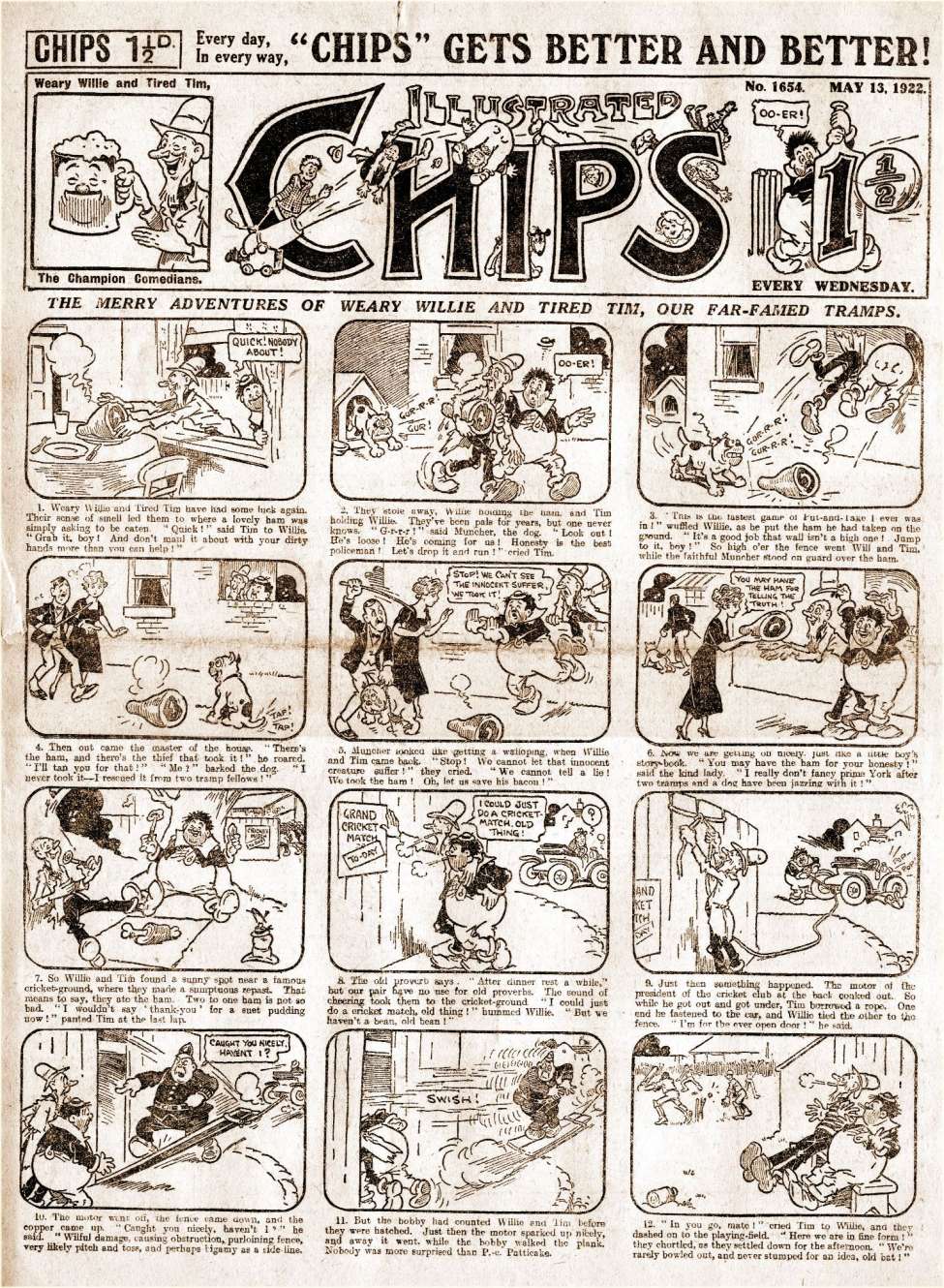
Cover of Illustrated Chips, No: 1654, May 1922 - when 'Chips' was 13
John did get his leaving certificate at Parramatta Intermediate Boys' High School - as shown by the schools lists then published in papers, his showing up in December 1925. He also commenced working as an apprentice at aged 16 as an ironmoulder at the Clyde Engineering Co. Ltd, Sydney. Unfortunately his father, then aged 66, died, leaving his mother with six children aged from 16 down to six years of age.
GOFFAGE.-March 22, 1925, at Sydney Hospital, John, beloved husband of Violet Maud Goffage, of Queen-street, Westmead. At rest.
GOFFAGE. - The Relatives and Friends of Mrs. V. M. GOFFAGE and FAMILY, of Queen-street, Westmead, are kindly invited to attend the Funeral of her late dearly-loved HUSBAND and their FATHER, John, which is appointed to leave the Parlours of Metcalfe and Morris, Ltd., 115 Church-street, Parramatta, THIS DAY, MONDAY, at 1.30 o'clock, for the Church of England Cemetery, Rookwood. METCALFE and MORRIS, LTD., Funeral Directors, Parramatta. Family Notices (1925, March 23). The Sydney Morning Herald (NSW : 1842 - 1954), p. 10. Retrieved from http://nla.gov.au/nla.news-article16196489
The community rallied around this popular gentleman's family:
Mr. G. J. Martin secured splendid results in his effort on behalf of the wife and family of the late Mr. Goffage. A subscription list was entrusted to him and, with the help of several clubs In the Association, together with private subs., he was able to hand over, last week, to Mrs. Goffage, the sum of £22. Mention must be made of the special effort of Westmead C.C., which resulted in a sum of over £13 being included in the list. The statement of the fund was presented by Mr. Martin at the executive meeting on Tuesday, and called forth expressions of appreciation from members. CRICKET NOTES (1925, July 3). The Cumberland Argus and Fruitgrowers Advocate (Parramatta, NSW : 1888 - 1950), p. 10. Retrieved from http://nla.gov.au/nla.news-article103769805
Cricket would remain part of the family, girls included - this is Hazel mentioned in this report - and the Queensland branch of the Goffage family, John seniors' brothers children and great-grandchildren, are still among that states premier women schools' cricketers:
INTER-STATE WOMEN'S CRICKET AT THE S.C.G. TO-DAY
Inter-State women's cricket will be played in Sydney to-day for the first time since" the war. TWELVE . . Victorians arrived yesterday to meet N.S.W. II. at Sydney Cricket Ground to-day; and N.S.W. I. on Monday. The games' will be the result of a move started in 1928 when the N.S.W. women's Cricket Association was formed. Next year an All-Australian Women's Cricket Council will come into being.
It is intended to hold annual carnivals in each of the Sheffield Shield States, and to affiliate with the All-England Council. A visit from New Zealand women next season is a possibility.
The Teams
The teams to do battle this Easter include many champions. The Victorians are: Misses Roach (c.), J. Anderson, M. Tonkin. E. Beane, J. Sutton, P. Edwards, J. Reeve, J. Gay, T. Frazer, D. Deblin, R. Tucker. N.S.W. II.: Misses E. Shevill (c.), H. Goffage. M. Lofberg, T. Magnus, R. Shevill, E. Bloemfield, N. Bourke, P. Hazell, P. Knight, Ml. Mudie, V. Turner. The first three are outstanding batsmen, and Miss Goffage is a fast bowler.
N.S.W. I.: r Misses M. Peden, A. Wedge-mund. M. Hannan, D. Blake, F. Blade, W. Brown. B. Peaen, 2.- Pritchard, E. Carpenter, E. Preddey, M. Rickson. Miss Blade is the only left-hand bowler in the association. ' , Official Entertainments The players will attend an official luncn at Centennial Park Kiosk to-day, and the State Theatre to-night. To-morrow they will be entertained by Sans Souci Club to a car picnic to Bulli. The Victorians will leave at night. INTER-STATE WOMEN'S CRICKET AT THE S.C.G. TO-DAY (1930, April 19). Daily Pictorial (Sydney, NSW : 1930 - 1931), p. 27. Retrieved from http://nla.gov.au/nla.news-article246121572
However, as John's war records show, he had served with the local militia up until 1925-1926 when this was suspended as he 'left the area' - to work to support his mother and siblings. His lifelong drive for work, hard work, and grabbing every opportunity offered, surely stems from this experience. He threw in the apprenticeship, you cannot feed six mouths on those wages, and there commenced an additional 'education' in the eastern Australian bush as a drover, shearer and boundary rider. He also later worked as a deckhand in coastal boats, as a pearl diver, and as an assistant in a Sydney wine cellar.
His war record papers also show he was a swimming coach as well as amateur swimmer (and boxer). He was back in Parramatta by 1931 where his creative instincts were given more time - recollections of his own as well as those by people who knew him, recount he was a writer of poetry, articles for newspapers (we found one - which is under 'Extras') as well as a painter of pictures; selling some of these to help make ends meet.
Here he became involved in the entertainment industry, first as a member of the Cumberland Musical Society, as shown by this 'swimming' article and a letter penned to the local paper when the Hon. Secretary of that society.
"EYES RIGHT"
Cumberland Musical Society's Revue
The curtain went up on a gratifying "house" last Thursday night, when, at the Parramatta Town Hall, The Cumberland Musical Society produced a potpourri of entertainment with their musical revue, "Eyes Right." ... The sketches handled by the men were very well carried out-the acting of W. Tookey, A. Wagner,,J. Liddle, F. Mackin, D. Methern, Tom Chalmers and Jack Goffage all earning well merited applause. Parramatta Day by Day (1932, July 14). The Cumberland Argus and Fruitgrowers Advocate (Parramatta, NSW : 1888 - 1950), p. 13. Retrieved from http://nla.gov.au/nla.news-article105929308
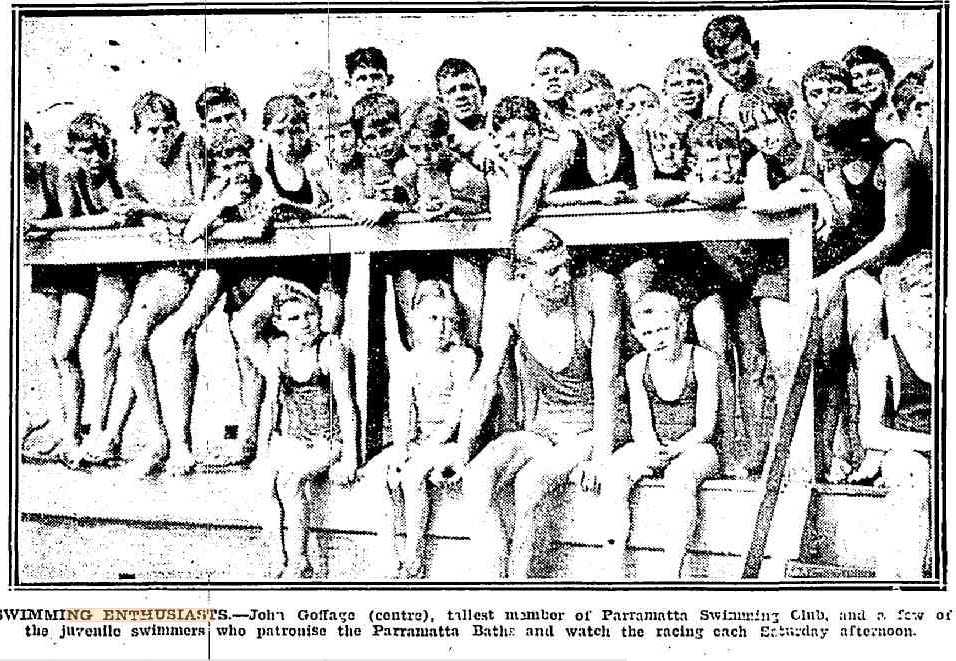
SWIMMING ENTHUSIASTS.--John Goffage (centre), tallest member of Parramatta Swimming Club, and a few of the juvenile swimmers who patronise the Parramatta Baths and watch the racing each Saturday afternoon. No Title (1934, April 5). The Cumberland Argus and Fruitgrowers Advocate (Parramatta, NSW : 1888 - 1950), p. 18. Retrieved from http://nla.gov.au/nla.news-article104579426
Musical Society's Aims and Objects
(To the Editor.)
Sir,-- Scepticism! How often in these days of economical upheaval does this sordid human trait intrude its doubting way into the mind of the man in the street. How often do we find the motives of the individual, no matter how honest and altruistic they may be, stretched on the rack of public scepticism? To try and banish this scepticism with regard to the motives, aims and ideals of the Cumberland Musical Society, I am forwarding this explanatory letter to your paper, trusting that in the interests of the amateur theatrical movement in general, you will be good enough to publish it. The aim of the Cumberland Musical Society is to bring to Parramatta the cream of the musical operettas, which have been presented in the past by J. C. Williamson and Co. to give to the young people of Parramatta an instrument by which they can develop whatever latent talent they have, either vocal, dramatic or instrumental, and to generally foster the development of the musical culture, the ultimate aim being to financially assist the many local charitable organisations.
The management committee is endeavouring to establish a credit balance at the bank substantial enough to ensure them of complete financial safety. On the completion of a show, after finalising all liabilities incurred during production, and re-establishing this safety bank balance, the society would, in the event, of them having satisfactory houses, be in a position to make a donation of the sum remaining to charity.
That we have been unable up to the present to do this is due firstly to the mediocre house that we have experienced, and secondly, to the high cost of production. This letter may be received sceptically; it may seem to the casual reader an appeal on the society's behalf for unmerited charity; or, through purely explanatory, merely a new form of advertising propaganda. But credit must be given when it is due. The Society can justly claim to rank with the State's best amateur societies. We present bona fide shows, the cast, ensemble, ballet and orchestra are all residents of Parramatta or ist immediate environs, and have favourably impressed critics of good standing with the quality of our productions.
I conclusion may I thank the 'Argus' for the assistance we have received from it in the past. The cordial co-operation rendered us has been of inestimable value. With its further assistance and the patronage of the people of Parramatta, the Cumberland Musical society will become the greatest charitable organisation the district has ever known - Yours, etc.
JOHN W. GOFFAGE
Hon. Sec., Cumberland Musical Society.
Musical Society's Aims and Objects (1935, June 6). The Cumberland Argus and Fruitgrowers Advocate (Parramatta, NSW : 1888 - 1950), p. 4. Retrieved from http://nla.gov.au/nla.news-article105100503
He also met and married a 19 year-old girl with similar interests:
GOFFAGE-FERGUSON-November 18, 1935 at St. Stephen' s Presbyterian Church, Sydney by Rev. James McLeod, John William, eldest son of the late Mr John Goffage and Mrs M. Goffage of Parramatta to Jean Stewart, only daughter of Mr. and Mrs. John Ferguson, of Belmore. Family Notices (1935, November 30). The Sydney Morning Herald (NSW : 1842 - 1954), p. 16. Retrieved from http://nla.gov.au/nla.news-article17218630
HOW LOCAL GIRL BECAME STAR
Patience Rewarded JEAN FERGUSON'S RISE
The romantic story behind the meteoric rise of Miss Jean Ferguson, formerly ticket-seller and now taking a part at the Minerva Theatre, had many of its chapters at Parramatta. Miss Ferguson was last week taken from her uniformed status in the foyer of the theatre, and is now playing a part in the show, "Good Morning, Bill." She was familiar to many Parramatta people as a dancing teacher, and later as proprietress, with her husband, John Goffage, of Lynam's soda-fountain in Macquarie-street.
Jean is 22. Since her tiny-tot days she has cherished a burning desire to be an actress. But her ambitions were more than just vain dreams-she had ideas of methods to reach her goal. When she discontinued her studies at St. George High School, Jean's father gave her a sum of money to start a school of dancing. Miss Ferguson conducted her school at Parramatta for about a year. She then took up a position as nurse for a local dentist. It was while in this role she married John Goffage, and the two shortly afterwards took over the shop in Macquarie-street.
LOCAL DRAMA WORK
Tenacity of purpose kept Jean to her object, the stage. Though tired after her teaching, or work in the dental surgery or the shop, shite attended at night Colina Spicer's Studio Theatre League. In the League she studied many parts, and, with Miss Spicer's assistance, gained a further insight into the art of acting. "Good Morning, Bill," which gave Miss Ferguson her big break, was once reviewed by the League as a play-reading. Little did the coming star dream that "Bill" would prove so useful.
IN THE "DEN"
The Goffage's shop was never without several of the couple's large circle of friends. But few were aware of the "den" upstairs. Here, for one day a week, Jean adjourned in solitude, preparing herself for the day when she would really get her chance. Locked in, she trained herself strictly to her art. It included acting, voice-production, and short story writing. Her six-feet-three husband, also of artistic temperament, spent a day every week in the 'den," sketching and writing poetry. Their ambition to reach Hollywood resulted in Mr. Goffage buying a ketch at Sydney Harbor. Their scheme was a to sail to California and enter the movie world. But, for some reason or other, the ship never set sail.
Both Jean and her husband were members of the Cumberland Musical Society. A lovable tint in Jean's character was her fondness of animals. Much of the milk from the shop refrigerator went to the numerous miserable kittens and puppies which were never turned away. Miss Colina Spicer this 'week recalled her associations with Jean Ferguson at the Theatre League, where Jean studied the part now taken at the Minerva by Joy Howarth. "She had a particularly soft voice," said Miss Spicer, "and possessed a great amount of personal charm. I was always impressed by her talent for acting. I think Jean should go a long way." HOW LOCAL GIRL BECAME STAR (1939, August 2). The Cumberland Argus and Fruitgrowers Advocate (Parramatta, NSW : 1888 - 1950), p. 1. Retrieved from http://nla.gov.au/nla.news-article106207203
However, by the Spring of 1940 they had divorced with a Decree Absolute granted in March the following year:
DIVORCE SUIT
Former P'matta Couple
Before Mr. Justice Halse Rogers on Monday Colina Jean Stewart Goffage (formerly Ferguson) applied for a divorce from John William Pillbean Goffage, on the ground of non-compliance with a restitution decree. A decree nisi was granted. Mr. and Mrs. Goffage, who were married at Sydney in 1935, were formerly well known at Parramatta. DIVORCE SUIT (1940, September 18). The Cumberland Argus and Fruitgrowers Advocate (Parramatta, NSW : 1888 - 1950), p. 1. Retrieved from http://nla.gov.au/nla.news-article106204685
For the 18 months that they ran Lynam's soda fountain before the marriage broke down. When that business was sold he apparently bought a cabin cruiser, not a ketch, and lived on that as well as working several jobs again and would have a drink at the Black and White Artists Club at Circular Quay - a favourite haunt of actors and journalists and his first film role as an extra in Come Up Smiling (1939). One job he held at this time was working in a wine cellar where Ron Whelan, assistant director for Ken G. Hall of 'On Our Selection' fame, was looking for a tall lanky fellow to contrast Bert Bailey in 'Dad Rudd M.P.' (1940). He was only in the film for 5 minutes, playing a fireman, but was noted for being visually funny and able to speak well, so much so that Herald cartoonist Jim Russell drew John Goffage in a carton after seeing this film.
The year 1939 was also when he met Ellen Kathleen Jameson, a 37-year-old dressmaker who ran a dress shop called 'Quentin of Melbourne', she being known as 'Quentin'. Some anecdotes by the lady herself state she first saw him in a dinghy on the harbour, others state they met through a blind date at the Mayfair Hotel in Kings Cross and while he was still living in the cabin cruiser. A lady never forgets.
In 1940 Ron Whelan was working for Charles Chauvel in the casting of Forty Thousand Horsemen (1940), an Australian war film which tells the story of the Australian Light Horse which operated in the desert at the Sinai and Palestine campaign during World War I. Filmed mainly in the sandhills of Cronulla, the story follows the adventures of three rowdy heroes in fighting and romance and culminates at the Battle of Beersheba which is reputedly "the last successful cavalry charge in history". The film was clearly a propaganda weapon, to aid in recruitment and lift the pride of Australians at home during World War II, and considered the most successful Australian movie of its day here and was well received in Britain and the US.
He played a laconic tall bushman, a role he would reprise over and over, and which made him a 'star'. Chauvel described him as "a cross between Slim Summerville and James Stewart, and has a variety of droll yet natural humour."
On May 20th 1941 he applied to join the RAAF and was finally enlisted the day after his wedding to Ellen, May 28th. These documents provide insights into his pre and post WWII activities - NB: Flat 3, 66a Darlinghurst Road, Kings Cross - May 1941, records from the National Archives of Australia (NAA):
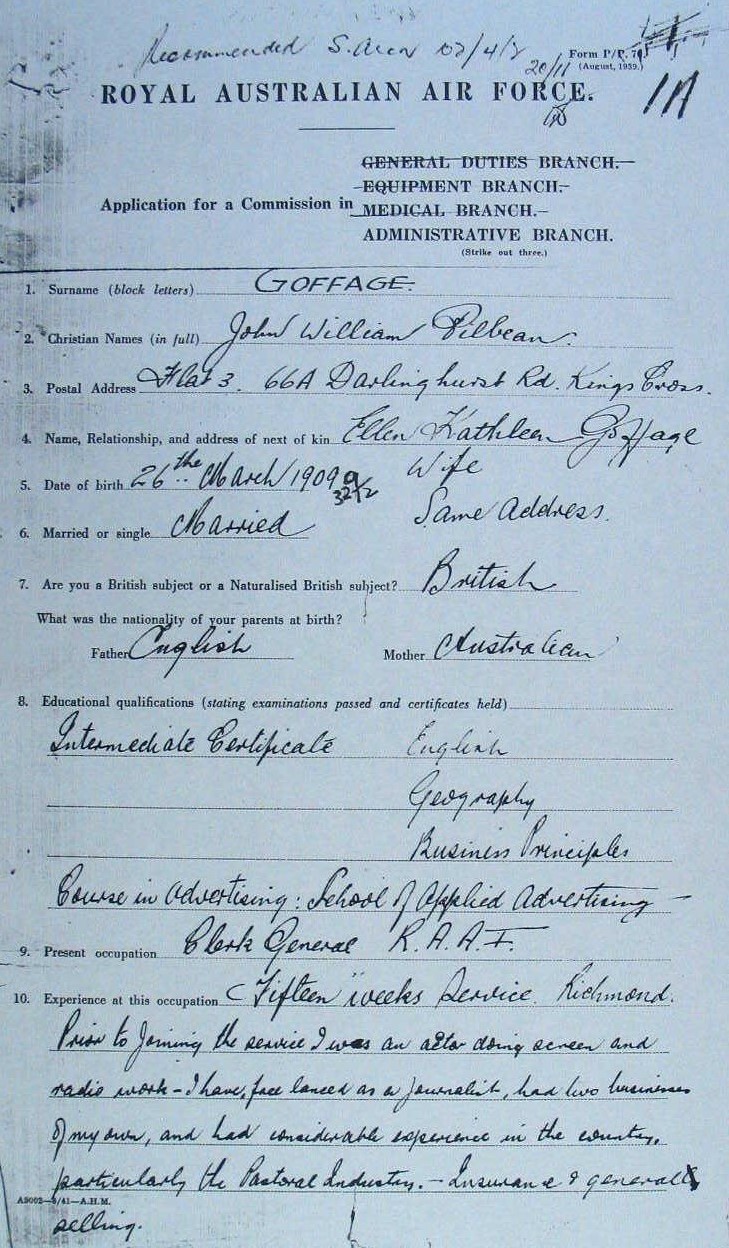
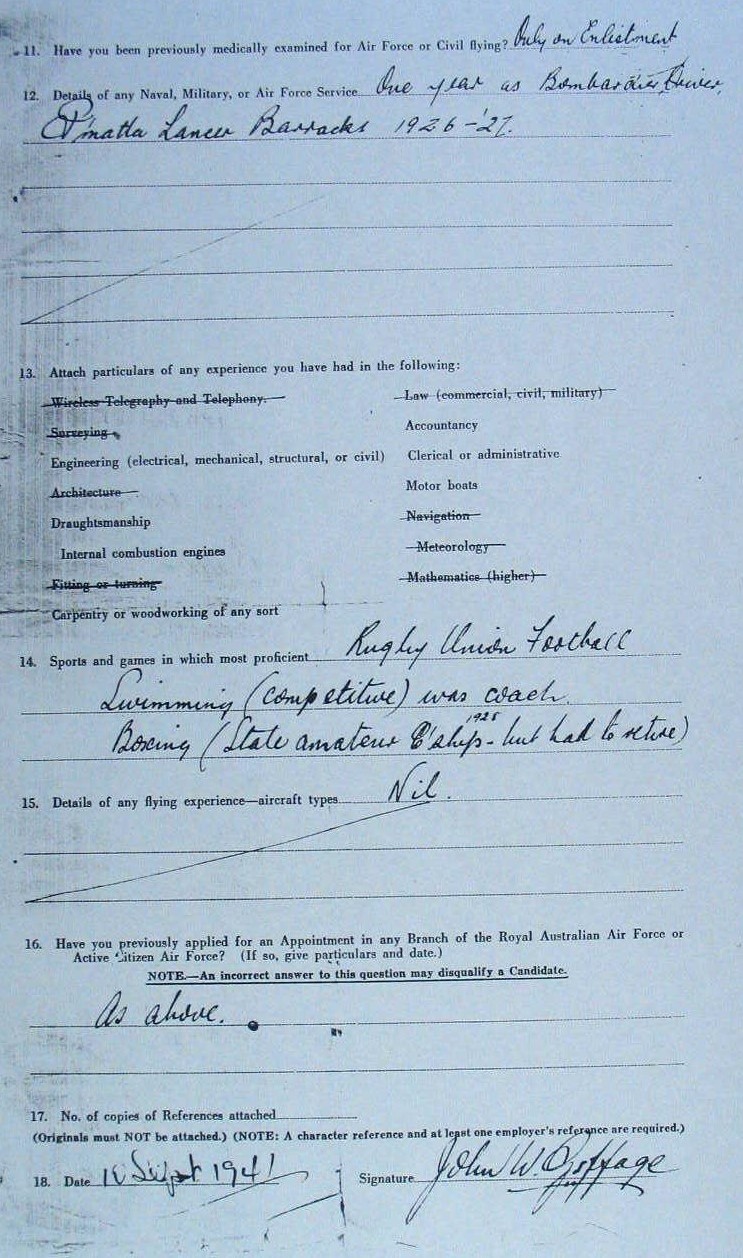
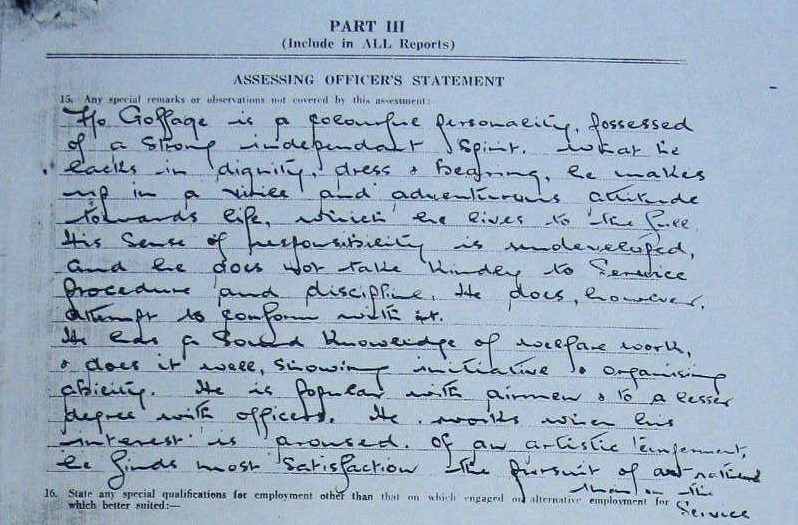
In a prior letter, in trying to track down his Returned Badge, he states he has lived in four places since returning home. A response also states he is entitled to the 1939-45 Star, Pacific Star, War Medal 1939-45, Australian Service Medal 1939-45 and Returned from Active Service Badge. However, the number of the Returned from Active Service Badge was not known by the Albert Park Barracks, although it was eventually tracked down.
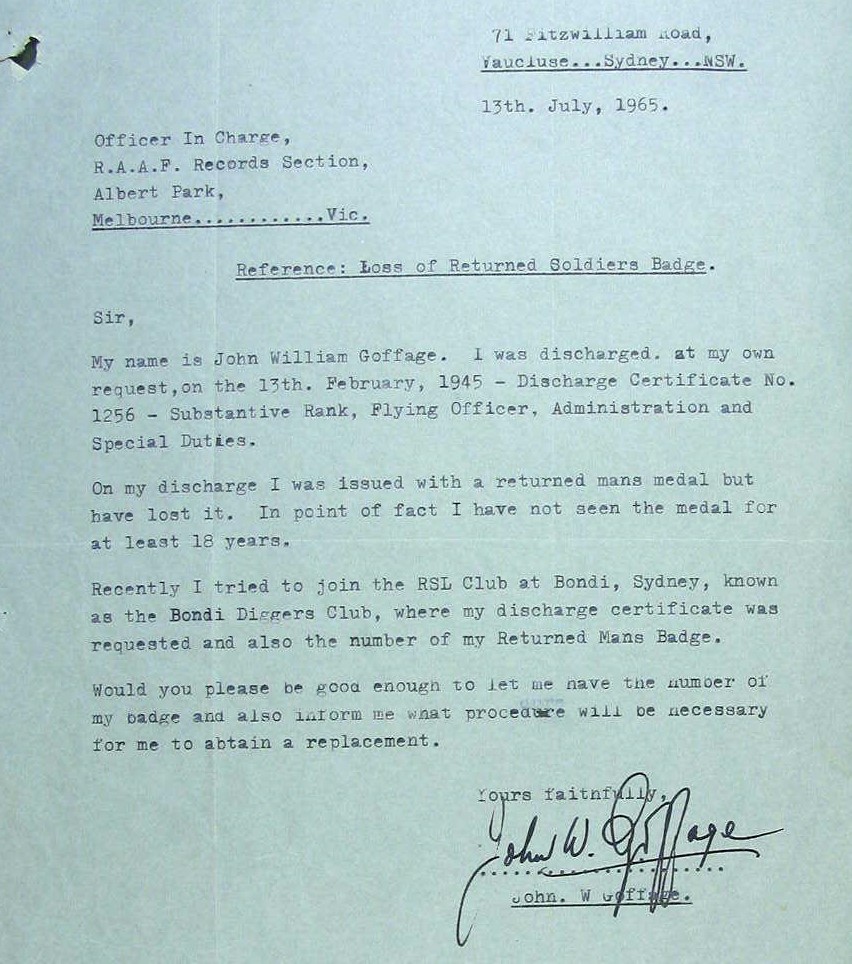
He was assigned to welfare and amenities duties, putting on a show at Narromine prior to being promoted to Flying Officer and sent to New Guinea, organising relief entertainment for those stationed there. When speaking to Henry MacPhillamy in 2011 about his service in New Guinea he described it as 'a terrible place. We were there for 19 and a half months. It was a shocker. Pustular dermatitis, sand flies, malaria, scrub typhus...'
Henry said there was a lot of deaths from diseases, a lot of men getting 'talkie talkies' from too much stress and working for days on end without sleep and having to be 'sent down', and deaths from fighting. Those battling to recuperate really really needed a few moments relief.
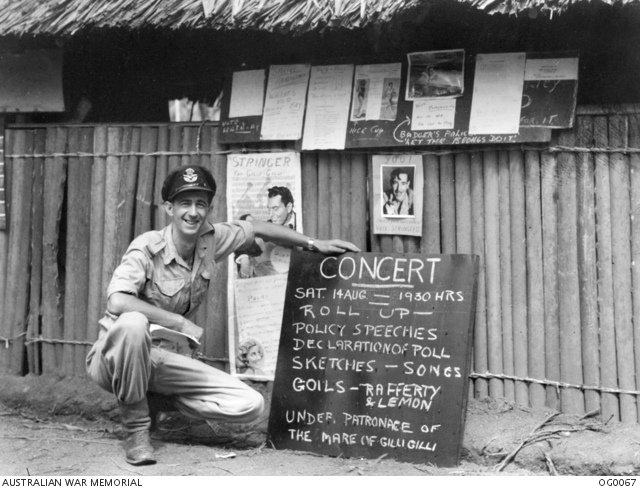
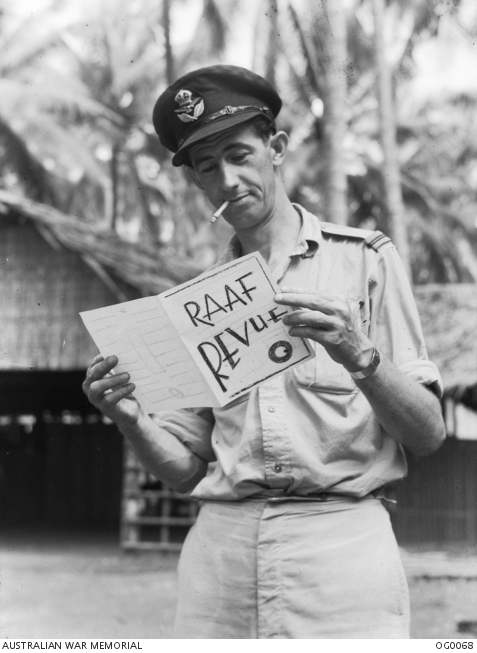
PAPUA. 1943-08-14. PILOT OFFICER GOFFAGE RAAF (BETTER KNOWN AS THE ACTOR CHIPS RAFFERTY) NEXT TO A NOTICE FOR A CONCERT TO BE HELD AT THE RAAF BASE AT GILI GILI IN THE MILNE BAY AREA. AWM: 4113876. Maker: Harrison, John Thomas and Pilot Officer Goffage RAAF (better known as the actor Chips Rafferty) reading the programme for a revue to be held at the RAAF Base at Gili Gili in the Milne Bay area. Date made: 14 August 1943, AWM: 4089156, by same photographer, courtesy the Australian War Memorial
During the war, Rafferty was granted leave to make films, appearing in a short featurette, South West Pacific (1943), directed by Hall and was reunited with Chauvel in The Rats of Tobruk (1944), filmed mainly at Curran's Hill near Camden this became the hit movie of the war. Although not a great film according to some critics, the performances of Goffage and Peter Finch were considered standouts and added to his fame.
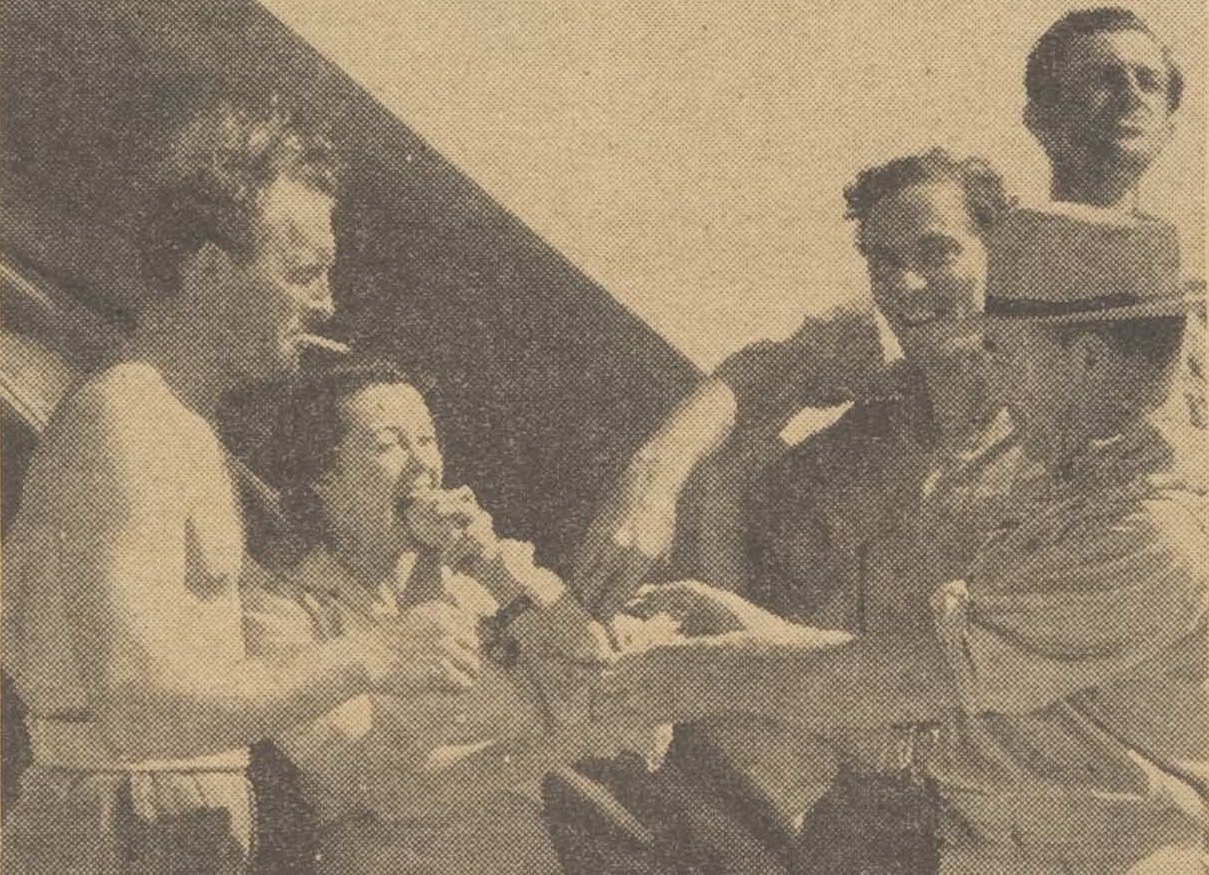
MID-MORNING SNACK for leading men. From left: Grant Taylor, Mrs. Chauvel, Peter Finch, Mr. Chauvel, and (at back) "Chips" Rafferty (in private life P/O. John Goffage). Tobruk Rats help to put epic siege on screen (1943, November 6). The Australian Women's Weekly (1933 - 1982), p. 9. Retrieved from http://nla.gov.au/nla.news-article46936879
He was demobilised on February 13th, 1945 at his own request to act in propaganda films for the Department of Information. There are also indications he hurt his back and suffered an ear injury during this conflict although his post-service records indicate good health. He came home sporting a moustache - so many men in the RAAF in WWII grew a moustache:
RECOGNISE HIM?

F/0 John Goffage, the "Chips Rafferty" who acted in "Rats of Tobruk," is now the proud owner of a flourishing "operational moustache." RECOGNISE HIM? (1945, January 25). Western Mail (Perth, WA : 1885 - 1954), p. 4. Retrieved from http://nla.gov.au/nla.news-article38559817
His first post-war feature, The Overlanders (1946), marked a turning-point in his career, and not just for the £50 per week some biographers state he received - an amazing amount for then that set him on the path to being able to afford land in Pittwater. He was cast by British director Harry Watt in the role of a bushman who headed a team which drove a huge herd of cattle across northern Australia beyond the reach of possible Japanese invaders. With a background in documentaries, Watt was determined to create authentic Australian characters in a factually based drama that featured our dramatic landscapes. Rafferty continued to develop his character of the tough, laconic Australian bushman in this film and became known for being like this both in public and on screen.
The film's plot sounds alike the 2008 Baz Luhrmann hit ‘Australia’:
LEADING ROLE IN AUST. FILM FOR ARMY NURSE
The feminine lead for Harry Watt's Australian film, "The Overlanders," was discovered on the cover of an A.A.M.W.S. magazine. She is Corporal Daphne Campbell, 20, who since 1942 has been working in a North Queensland hospital as a nursing orderly.
A country girl from Orange, where her parents, Mr. and Mrs. Victor Campbell, own a farm, Daphne has been granted special leave by the A.A.M.WS. to act in the film.
Mr. Watt, who is making the film for a British studio, said yesterday: "We are not glamorising her, and we are not turning her into a film star," he added. "The Overlanders" tells the story of the wartime cattle-trek from the Kimberleys to Queensland. The cast is made up of professionals, amateurs, and some who have never acted in a film before.
Daphne plays Mary Parsons in the droving family which has John Nugent Hayward as Pa Parsons, Jean Blue as Ma, and 12-year-old Helen Grieve as a film Helen. Jean Blue, a sister of Pathology at Prince Henry Hospital, Sydney, was found by Mr. Watt in a New Theatre League show, "Henry Lawson." Pigtailed, wiry young Helen Grieve is the daughter of Dr. and Mrs. Ronald Grieve, of Lindfield, the latter a great friend of Mr. Watt's sister.
Chips Rafferty (John Goffage), the well-known actor, has his first serious role on the screen as the boss drover, Dan McAlpine.
"Chips' role, shows what the un-demonstrative man of the outback did for Australia when the Japanese invasion was closest," Mr. Watt said.
The well-known actors, Peter Pagan, as the sailor, and John Fernside, as "Corky," complete the list of principals. Aborigine Clyde Combo, who appeared in an Australian film 14 years ago, is repeating his real-life role of Northern drover in the important role of Jacky.
Production of the film began in Sydney on Monday, and after a week the company will go on location for three or four months, first to Alice Springs, and then 800 miles north for climax scenes on the coast.
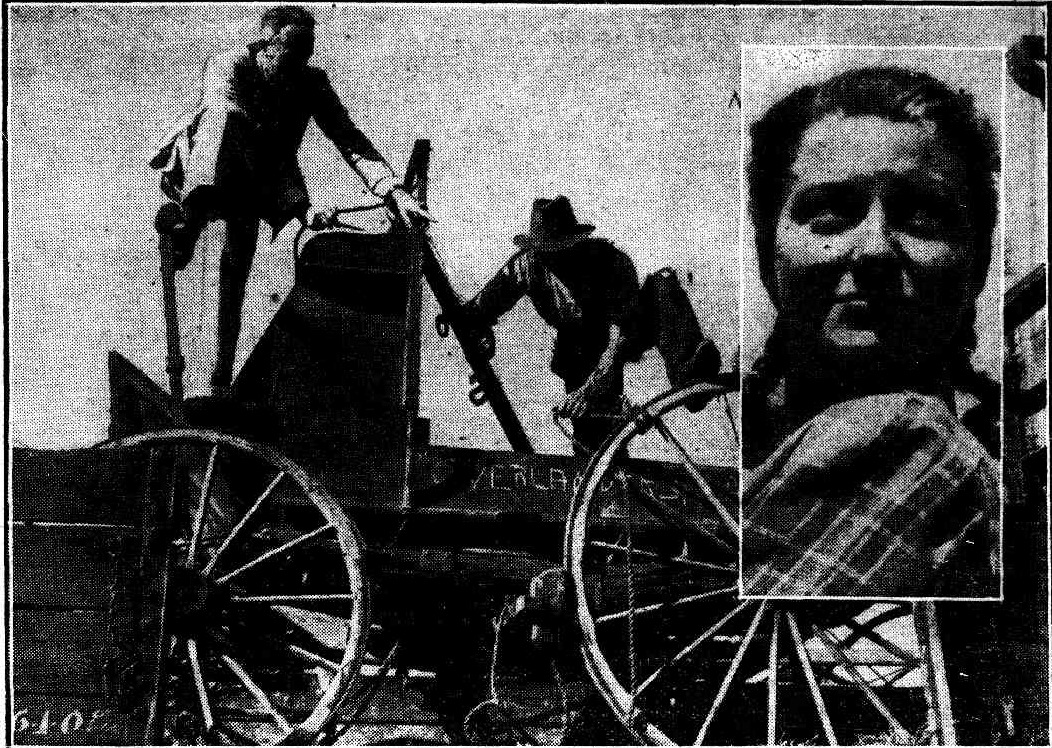
ORIGINAL Cobb & Company's coach bought by producer Harry Watt for use in the film, "The Over landers/' to be made in Australia. The coach is about to be taken to Alice Springs. Inset: Cpl. Daphne Campbell, A.M.W.A.S., who will play the feminine lead in "The Overlanders." LEADING ROLE IN AUST. FILM FOR ARMY NURSE (1945, March 22 - Thursday). The Daily Telegraph (Sydney, NSW : 1931 - 1954), p. 9. Retrieved from http://nla.gov.au/nla.news-article247661401
Indigenous actor George Henry Murdock as 'Nipper' was also part of this production and would also take roles alongside Goffage in Bitter Springs (1950), Kangaroo (1952), the Eureka Stockade (1949) and The Phantom Stockman (1953) - the film made by 'Platypus Films' - a Goffage and Lee Robinson production. Photos taken on film sites during production show John staring with love at aboriginal children who would visit these sites and he was outspoken in public too - his love for walking alongside these people still strong from his childhood would persist throughout his life:
CHIPS' RAFFERTY SUPPORTS NATIVES
Sydney, January 12 — ‘Chips' Rafferty was a popular figure when he appeared in person, to give a talk at the Lycieum Theatre ' this afternoon. He made an earnest plea for further assistance to the Australian' Aborigine and told of the good work, done by the natives. . He said that Henry Murdock, who appeared in the 'Overlanders.' was an aborigine who was well educated and carried Shakespeare 'because he liked that author’. If given a chance the natives responded to education…… "CHIPS" RAFFERTY SUPPORTS NATIVES (1947, January 13). Barrier Daily Truth (Broken Hill, NSW : 1908; 1941 - 1954), p. 3. Retrieved from http://nla.gov.au/nla.news-article141169245
As with many Australian Actors he chased the work overseas:
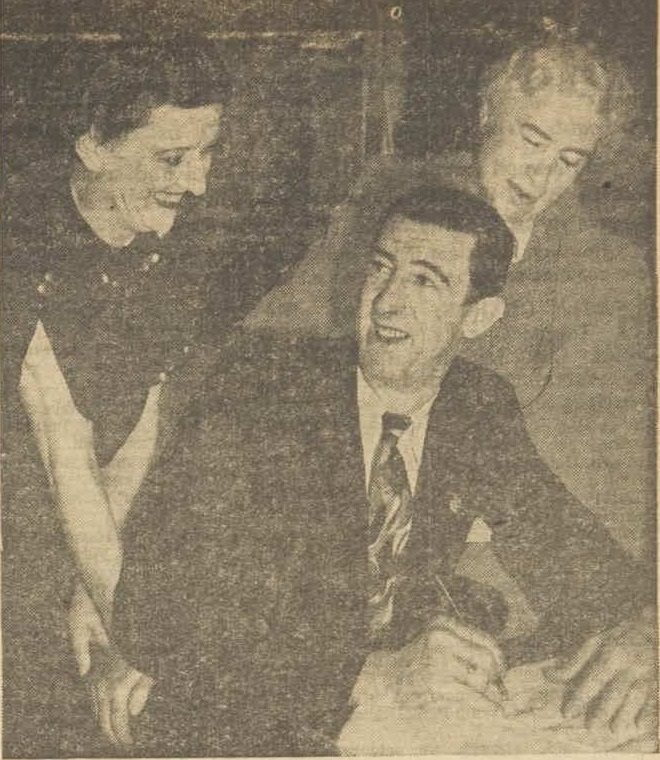
CHIPS RAFFERTY, Australian film star, who will begin work soon in England in "Joanna Godden." Ealing Studios have taken up the option on his contract, which Chips is signing here, watched by his mother, Mrs. Violet Goffage, and his wife. Will spend holiday in Australia (1946, June 15). The Australian Women's Weekly (1933 - 1982), p. 35. Retrieved from http://nla.gov.au/nla.news-article47502426
These stars put us on world film map
By DONALD HORNE
TWO Australian film actors — "Chips" Rafferty and Ron Randell — helped put Australia on the world film map last week.
Rafferty is star of the first-class British-made "The-Overlanders," which had its world premiere in Sydney on Friday last week, and on Wednesday in the same week Ron Randell — star of the Australian film ''Smithy"-— signed a contract with the Columbia Picture Corporation of America. ' Randell sails for "Holly wood this month, and Rafferty is now in London making a film for Ealing Studios, the company which made '"The Overlanders."
One of the tallest men in movies at six feet seven, Chips Rafferty is that almost mythical character, "the typical Australian." Loose-limbed, gangling, at times strangely reserved, Chips is often laconic, but never unfriendly. Among people he knows he relaxes easily, is sometimes even wildly hilarious and keen that people should join in the choruses of his almost endless repertoire of songs. He always knows more songs than anyone else at the party.
Rafferty's real name is John William Pilbeam Goffage, and he was born 37 years ago at Broken Hill. His family moved to Adelaide when he was two. For the next 10 years he lived with them in 16 towns and three States. His childhood ambition was to become a metallurgical-chemist, but the way family funds stood prevented this, and he got his first job in an iron foundry. He has had so many jobs since that he can't remember all of them. They took him all over Australia, and as far away as the China Sea. He dug post-holes in Queensland, learnt long-distance diving from Thursday Island natives. He was messenger boy, storeman, office boy, apprentice engineer, cadet reporter.
He saw the outback as shed-hand, shearer, wool-presser. wool-classer, station-hand, drover, canecutter, fencer. He gouged for opals and fossicked for gold, lumped wheat, worked on the roads as a navvy and on boats as a deckhand. He trapped rabbits and shot kangaroos. Chips really knocked around.
Most of the time he was broke. When he had money he came to town and busted it. Through all these jobs he saw life the hard way, learnt to judge people for what they were really worth, and not what the social ticket around their necks said they were worth. By the late thirties he had set himself up in a milk bar in Parramatta. But he tired of the milk trade, and came to the city as cellarman in a wine and spirit store. . . He bought a 40-foot boat, and lived in it on the Harbor— and when fire destroyed the boat one night, Chips was left, for the umpteenth time in his life, without a razoo. He worked in a wine bar for a while, but left because he didn't like the people.
He was selling subscriptions to a trade journal in 1940 when his big break came. With practically no experience, except an interest in amateur theatricals, which he had taken up for his own amusement, Chips was chosen for one of the leading roles in "40,000 Horsemen." Chips had begun his film career at 31.
People are sometimes disappointed when they first' meet Chips at a party. As his wife, Quentin Goffage, puts it: "They expect him to stand on his head — or something." Likely as not Chips will just go into a corner for a while and sprawl over a book— to the dismay of any host who misinterprets this as boredom. He is a prolific reader, likes to chew ideas over and over.
"He is a very serious minded bloke," says Quentin. "He is always worrying about politics, and was very keen to cast an absentee, vote while he was in London." His favorite authors include Aldous Huxley, H. Q. Wells, Eric Linklater, Ogden Nash, and Thurber. He believes that no food ever comes up to his wife's cooking. As Quentin says: "If I cooked an old boot and served it up to him he would think it was glorious."
He is an old hand at eating Chinese food, and for years has been eating Greek food at the Sydney Greek Club. His favorite drinks are claret and beer, and he prefers to roll his own cigarettes, becomes unhappy if you insist that he smoke a ready-made. His favorite card game is patience. Quentin says that when he has something on his mind he will play patience for hours.
Pictured as a horseman both in "The Overlanders" and "Forty Thousand Horsemen," an earlier film, Chips is a really genuine animal lover. Some of his friends believe that basically, he loves animals more than human beings. He loves children, and they love him with that instant reaction a child has when it knows it has met a friend. All his friends — many of them artists, journalists, actors — have a warm, sentimental attachment to Chips, but he is no bright lights boy. Both he and Quentin have found they have to attend far too many functions for their liking.
"One party a week is enough for us," says Quentin. "I don't know how Chips is standing up to it in London."
Painter Bill Dobell, one of Chips' friends, is keen to paint Chips some time. He should make an excellent subject for a Dobell portrait. Most people have a secret ambition. Chips wanted to become a painter. He did a fair bit of painting in the old days, but has had to give it away now. He still likes talking to painters and following their work. His favorite painter, is the French post-impressionist, Vincent van Gogh. Chips is easy in any company. He bowed low and then chatted informally with Princesses Elizabeth and Margaret Rose when they visited him on the set at London recently. After the meeting he wrote back to Quentin that the two Princesses were "quite lovely to meet." ' "It was just like talking to some of the nice little girls in Australia," he said. Quentin says Chips may inwardly be quite sick in the stomach with nervousness, but he will never let it break through his outer composure. He has perfect repose. Quentin is still Chips' greatest fan, and his most energetic publicity agent. She is also Chips' favorite audience. These stars put us on world film map (1946, October 5). The Daily Telegraph (Sydney, NSW : 1931 - 1954), p. 16. Retrieved from http://nla.gov.au/nla.news-article248405520
Rafferty Winging His Way Home
HOLLYWOOD, December 15. --The Australian film star, Chips Rafferty, left by Pan-American Airways clipper for Sydney early today to keep his promise to be home by Christmas. The booking of his passage on the aircraft under the name of John Goffage, actor, ended a five day whirling tour of Hollywood studios and night spots. But Chips promised to return here one day to make a picture.
Rafferty chose the trip home instead of awaiting the Broadway premiere of his film, "The Overlanders," next week. Since Pan-American Airways has not yet inaugurated a through service to Australia, Rafferty will land at Auckland and catch a T.A.A. plane to Sydney. Rafferty Winging His Way Home (1946, December 16). Barrier Miner (Broken Hill, NSW : 1888 - 1954), p. 2. Retrieved from http://nla.gov.au/nla.news-article48485207
MUM’S COOKING WAS PIE FOR CHIPS
"Overlanders" Star Spends Christmas In Parramatta
After winning fame for his part in "The Overlanders," visiting England to make a film, and mingling with Hollywood's brightest stars, Chips Rafferty came home to Parramatta last week to "spend Christmas Day with Ma."
An Argus reporter found lean, sun-tanned Chips sleeping-off Christmas dinner on a cane settee on the back verandah of his mother's neat brick cottage in Early Street. * "Just call me Chips," he said as he unwound his six-feet-six from the settee to shake hands. .. -"Boy! That was some Christmas dinner I had," he added.- 'I've sampled- food by some of the best chefs overseas, but Ma's cooking will still do me. . ''The .only thing I'm disappointed about is that I didn't get a tray out of the pudding.' -
Chips said it was his first visit home since returning from abroad, and his second Christmas home in six years. - "t's .good to be back in the old town,'" .he added.
Chips explained that his mother, tired from the excitement of his visit, was resting...
''Ma's tickled about my success in films, but you know, mothers --she'd probably think just as much of me if I'd wound up "on the end of a pick and shovel," he said. Rolling a cigarette (he declined a "tailor made"), Chips went back in memory to the days when, as John Goffage, he ran a milk bar in Macquarie Street, Parramatta.
"I worked from 8 a.m. till midnight for 18 months," he said. "But sometimes I think making films is just as crazy." Chips recalled happy boyhood days 'in the "old swimming hole," nocturnal visits to river bank' orchards with, the "gang ...."
Drawing on his cigarette he told of hectic schooldays, and remembered that his first acting experience was with the old Cumberland Musical Society, in which he was the comedian. He recalled too, the days when he sculled on Parramatta River, played with the local football clubs and was a member of the district swimming club.
''I'lI always had an advantage over my swimming opponents 'because I was so darned long," he said with his infectious grin. Chips said he had thoroughly enjoyed working in "The Overlanders," and was looking "'forward immensely to playing Peter Lalor in his new film, "Eureka Stockade." "It looks as-though I'll be in films for a while," he said. "If not, I can always go fishing."
"This will be the last you'll see me for a couple of weeks. I'm going into Smoke' until the new film starts." With a smile and. a handshake, Chips again draped himself on the settee to finish his sleep. . Happy at the return of his master., Chips' 16-years-old dog, pal, Felix, settled down contentedly beside him. MUM'S COOKING WAS PIE FOR "CHIPS" (1947, January 2). The Cumberland Argus and Fruitgrowers Advocate (Parramatta, NSW : 1888 - 1950), p. 1. Retrieved from http://nla.gov.au/nla.news-article105739363
A Bearded Chips Rafferty Attends Reception
Chips Rafferty, star of the Australian film, "The Overlanders," was given a civic reception at Parramatta yesterday. He was wearing a beard. He recently returned from England where he played in the Ealing Studios' production, "The Loves of Johanna Godden."
Rafferty's beard was grown specially for the role of Peter Lalor in his next film. "Eureka Stockade." Rafferty-in private life Mr. John Goffage-has lived at Parramatta for many years. He gained his first theatrical experience in the local musical society.
Addresses of welcome were made by the Mayor of Parramatta, Alderman Symonds, the Deputy Mayor, Alderman Musto, and Mr. G. C. Gollan, State member for Parramatta.
After the reception Rafferty was besieged by autograph-hunters. "Eureka Stockade is expected to begin production soon after Easter. Tentative locations are in the Oberon and Maitland areas. A Bearded Chips Rafferty Attends Reception (1947, January 23). The Sydney Morning Herald (NSW : 1842 - 1954), p. 3. Retrieved from http://nla.gov.au/nla.news-article27905818
There was another reason 'Chips' wanted to return home as soon as possible:
He Brought Her Roses Sweet
Unable through illness to attend the civic reception and dinner tendered her famous son, "Chips" Rafferty, last Wednesday, Mrs. J. Goffage, of Early Street, Parramatta, shed a tear over a bunch of red roses "Chips" took home to her. The roses were given to "Chips" for his mother by the Mayoress (Mrs. Symonds), at the civic reception. He Brought Her Roses Sweet (1947, January 29). The Cumberland Argus and Fruitgrowers Advocate (Parramatta, NSW : 1888 - 1950), p. 1. Retrieved from http://nla.gov.au/nla.news-article105732362
Throughout 1947 the versions of what he'd done previously appeared in papers across the country, wherever he was working or whenever one of his films was being played in theatres. A slection is loaded here to show what is the same and he added extra bits of threads that wove a down to earth person that epitomised the Australian 'mate' legend:
"Chips" Rafferty Back From Abroad

Australia will never be a major film-producing country, according to "Chips" Rafferty, Australian star of "The Overlanders," who returned to Melbourne yesterday after five months abroad.
Quiet-spoken, witty, and alert, Rafferty does not converse in the drawling "Australian" voice of The Overlanders character he portrayed, but he is nevertheless typically Australian, even when he does not produce an occasional slangy comment. Off the screen there is little slang in his conversation.
Determined to learn "the picture business" thoroughly, he spent his time in England and the United States making shrewd observation of production methods. Here are some of his views:
Australia must make pictures for the world market, and not simply about incidents in the nation's history. England is well able to meet Holly-wood on an equal basis because the English film equipment is newer, and the film executives have avoided building up the colossal overhead expenses of Hollywood studios.
Australia must concentrate on making three or four first-rate pictures a year, instead of a number of "pot-boilers."
Britain's 10-year Plan
Britain's sudden rise in the film business is due to an intelligent "10 year plan," whereby promising young men and women about 10 years ago were encouraged to enter the film business to be trained thoroughly. Britain's best pictures today were being made by directors in their thirties.
England's ascendancy in film production, and its gradual breaking down of the American stranglehold on exhibitors, was a promising augury for Australia's film future.
Because of Australia's excellent light for photography, we may do a thriving business making outdoor scenes for big British films.
Previous Australian films, like 40,000 Horsemen and Rats of Tobruk, suffered from the handicap of lack of exhibitors to show them.
And The Beard
Explaining his six-weeks-old beard, "Chips" said there were several reasons for it. He would wear it as Peter Lalor in the forthcoming pro-duction, Eureka Stockade, and felt that he would be more convincing as a real beard owner than one who spent an hour a day having make-up men stick one on his face with gum. "And it'll mean an hour a day extra in bed," he pointed out.
Mrs Rafferty, who was born in Yarrawonga, and "once sold frocks in Birchip for four years," accompanied her husband. She explained that she met him in Sydney. He was in a tiny dinghy on the harbour when she was introduced to him, and for half an hour she was afraid to climb into it. "But I'm very glad I did eventually," she declared.
"Chips" Rafferty and Mrs Rafferty will be guests of Cr Connelly, Lord Mayor, at luncheon at the Town Hall today. "Chips" Rafferty Back From Abroad (1947, February 13). The Argus (Melbourne, Vic. : 1848 - 1957), p. 3. Retrieved from http://nla.gov.au/nla.news-article22408529
Shots Of Chips
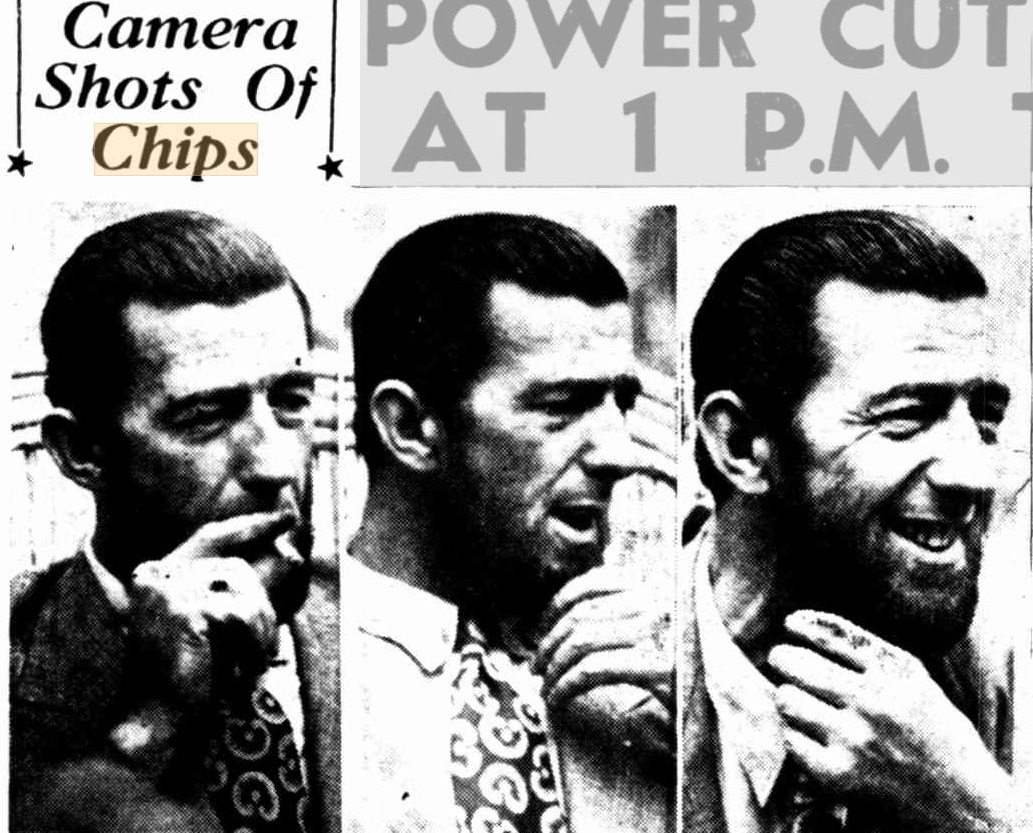
CANDID CLOSE-UPS of Chips Rafferty (top) as he was interviewed today. The beard is for his role of Peter Lalor in "Eureka Stockade." BELOW: Chips and "my wife Quentin."
.jpg?timestamp=1628981260848)
CHIPS Rafferty and "my wife Quentin" arrived in Adelaide today.
Ten minutes later-with only an hour to spare before making a public appearance at the Piccadilly Theatre-they sent for beer and had a talk with me. Chips, 35 years old and 6 ft. 6 In. tall, with a black beard grown for his new role as Peter Lalor in "Eureka Stockade." wore a light checked suit, a bright floral tie, and a "returned-from-active-service" badge in his buttonhole. His slim, dark wife--5 ft. 5 in.wore a pale blue and black printed! dress which she made herself, and had her hair dressed high in olaits. For "my wife Quentin" used to be a dressmaker, and still makes all her own clothes.
42 Kinds of Job
Stretching out his long legs and "rolling his own"-a habit which he says has horrified certain head waiters in Europe-Chips told me he had done 42 different kinds of job before he became a film star. Most were country jobs-droving, boundary riding, shearing and so on. His first professional stage appearance was as stooge to a conjurer in Parramatta when he was about 18. Seven years ago he met Quentin accidentally. He was living in a 40-ft. cabin cruiser in Sydney Harbor, and she was brought along to a party by friends. Quentin says she never thinks of herself as the wife of a film star she's just Mrs. Chips Rafferty.
Lots of Fan Letters
Chips has been getting hundreds of fan letters about "Eureka Stockade." One explained the origin of the word "brumby"-it said horses were imported by a man named Brumby at Richmond. N.S.W Some ran wild. and were called "wild brumbies." and finally the term became "brumby." Chips has great dreams for the future of the film industry in Australia. He does not believe a Government subsidy would be much help "No one in such a position knows anything about films and there would be too much interference." he said. What he likes to see is "'Commonwealth assistance 'in kind" such help as was provided in "The Rats of Tobruk" and "The Overlanders," when transport was provided and men for crowd scenes. He also wants to see a national theatre movement at a training field for artists. He thinks every capital city should have a building, as well as the town hall, set side for symphonic concerts, drama, and general repertory work, and built by Commonwealth or State Governments.
"The long-serving public deserves something like that." he said. This should go hand In hand with an interchange of artists between States, and the importation of distinguished producers and conductors. Although Chips assured me his wife's chief hobby was sleeping. Mrs. Rafferty said she was interested mostly in sewing and studying people
Father Was Here
Chips has a special interest in South Australia, because his father was secretary of the S.A Jockey Club from 1911 to 1913. A brother, who was born here. died while he was a prisoner of war in Malaya. A sister, born at Henley Beach, has married and left the State. Fame has not spoiled Chips Rafferty. He still has a friendly, easy manner, and a ready smile. And "my wife. Quentin," whose chief job obviously is to look after her film star husband, is just as natural. Camera Shots Of Chips (1947, March 11). News (Adelaide, SA : 1923 - 1954), p. 1. Retrieved from http://nla.gov.au/nla.news-article127074007
Another boat, more fishing:
NARROW ESCAPE OF CHIPS RAFFERTY
SYDNEY, Sunday.
A leading man in the Australian film industry, Chips Rafferty, and radio announcer Peter Finch had narrow escapes from serious injury this afternoon while fishing in Sydney Harbour.
After their launch had started a gasket of the engine blew out and dropped into the sea. They were towed to the Spit and while coming alongside got caught in the wharf. Both men are growing beards for their part in film productions. NARROW ESCAPE OF CHIPS RAFFERTY (1947, April 7). The Canberra Times (ACT : 1926 - 1995), p. 3. Retrieved from http://nla.gov.au/nla.news-article2711745
THE SEVENTH WEDDING ANNIVERSARY of Chips and Quentin Rafferty celebrated last night with a dish of rabbit at home.
"We had re-heated rabbit for our wedding breakfast, so just to prove success has not ruined the Raffertys we had rabbit again, only a fresh one this time," said Quentin. After dinner, Mr. and Mrs. Rafferty (their real name is Mr. and Mrs. Goffage) went on to see "The Dancing Years" where they were joined by Mr. and Mrs. Emile Mercier, who had been witnesses at their wedding. Sydney's Talking About— (1947, May 29). The Sydney Morning Herald (NSW : 1842 - 1954), p. 12. Retrieved from http://nla.gov.au/nla.news-article18028389
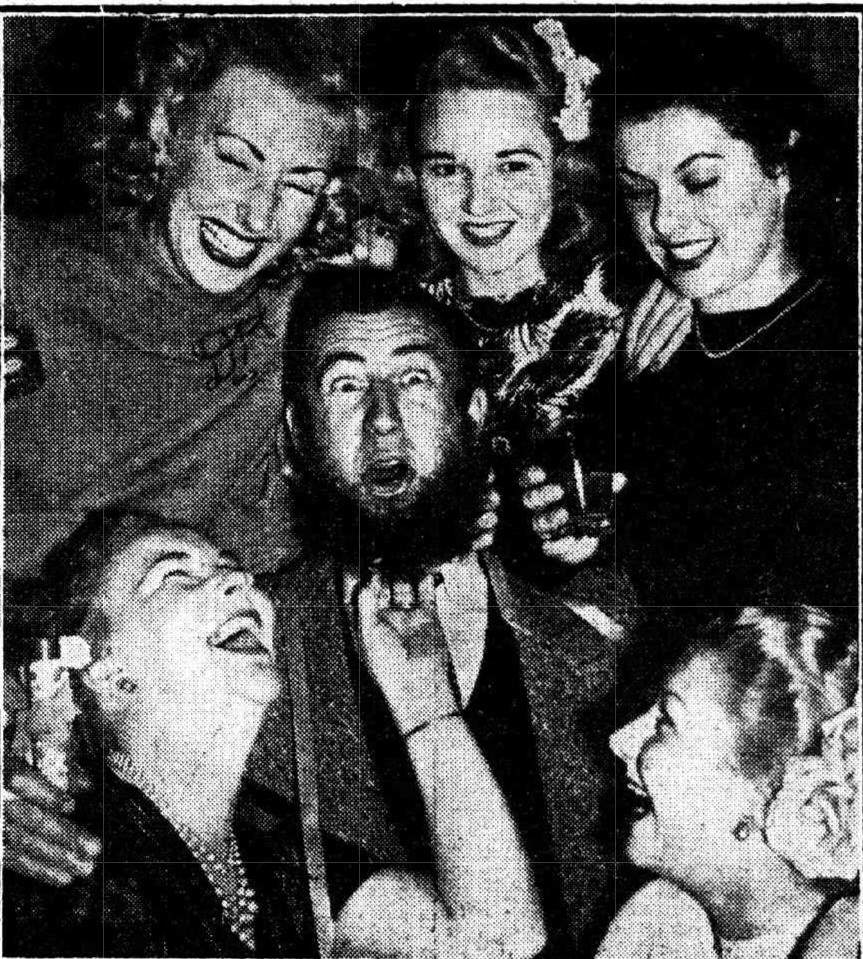
SHOWGIRL Diana Hartt (top left), who leaves for London on July 19, 'began, her farewells last night with a party at Dover Heights. Diana, badly burned in a fire at the Tivoli Theatre on September 1, 1945; was later awarded undisclosed damages after court action. With Diana last night were Australian film actor Chips Rafferty (centre), Sunday Telegraph beach girls Joy Brewer and Pamela Hookham (top), Mrs. A Smart, (her mother), and Joy Soltan (bottom). No title (1947, July 6). The Daily Telegraph (Sydney, NSW : 1931 - 1954), p. 56. Retrieved from http://nla.gov.au/nla.news-article248394793
Later this same year the mum he had come home to spend a Christmas with passed away. Although there's no way of knowing how much his grief impacted on his life at this time, they had clearly been boon companions before and since his father passed away. Almost every mum has a soft spot for her first born child, that intimacy of just them adoring each other and finding each other marvellous and perfect, as stated by 'Chips' himself, even after a second child is born, stays throughout a lifetime.
GOFFAGE Violet Maud-December 7 1947 at her home 32 Early Street Parramatta widow of John and dear mother of John, Joyce, Francis (dec ) Hazel and Charles aged 63 years At rest. Family Notices (1947, December 8). The Sydney Morning Herald (NSW : 1842 - 1954), p. 18. Retrieved from http://nla.gov.au/nla.news-article18052894
It was a gloomy, wet and depressing day. From the heavy clouds overhead' a steady 'mist Was falling as a funeral cortege approached Rookwood Cemetery. Behind the hearse, in a mourning coach, sat a grief-stricken bearded young fellow, the son of the hearse's occupant. Almost 12 months ago to the day the mother had joyously and tearfully welcomed the son home from afar, where he had made a great name for himself. A few months later she took ill, and on the day mentioned they buried her. She was Mrs. Violet Goffage. The chief mourner, John Goffage, who last Christmas Day declared, 'Mum's Christmas dinner beat anything the Hollywood chefs could serve.' John Goffage, of course, is none other than Chips Rafferty, of the movies. With him at the graveside as officiant was the Rector of Parramatta. Notes from the City (1948, January 9). The Scone Advocate (NSW : 1887 - 1954), p. 3. Retrieved from http://nla.gov.au/nla.news-article161566835
It was soon after this that all the constant work that 'another place to fish' and where quiet and peace could be found, and sometimes noisily disrupted if local lore is true, was sought. A June 1948 advertisement for a tiny plot of land right on the water at Lovett Bay caught the attention of the Goffages'. One report of this costing over £1200 seems preposterous when you read the size of it, but studies point out that post-war land and home prices rose from between 200 to 250% as the demand for homes for newlyweds could not be met with supply. A property in the same place must have been a lot more. These listings, among a whole gamut of properties in the same advertisement by auctioneers L J Hooker, address given as 98 Pitt Street, corner of Martin Place - with other solicitors for the other properties
PITTWATER--WATER FRONTAGE SITE
LOT 2 LOVETT'S BAY CHURCH POINT
1st CLASS WATER FRONTAGE HOME SITE elevated and having excellent views of Broken Bay. Approved plans and specifications for a cottage to be erected available to successful purchaser. Plan and full details from Auctioneers. LAND 76ftx50ftx142ft3inx165ft15in (H. W. M ) TORRENS TITLE
Solicitors RISHWORTH DODD & EINFELD
PITTWATER-1st Class Water Frontage Home
Vállele Lovett's Bay Church Point
A CHARMING WATER FRONTAGE HOME with VACANT POSSESSION and FULLY FURNISHED situated on a Headland with glorious views of Broken Bay. Well located as a private home or for conversion to Rest Home or Holiday Guest House Electricity Tele and ample water ACCOMMODATION 7 rooms kit and 2 bathrooms LAND 11 1/2 acres (600ft water frontage) TORRENS TITLE Solicitors RISHWORTH DODD and EINFELD. Advertising (1948, June 5). The Sydney Morning Herald (NSW : 1842 - 1954), p. 20. Retrieved from http://nla.gov.au/nla.news-article29762275
Vállele, vallar. is from Spanish v. fence, enclose within a fence or other barrier; separate with a fence or other barrier, from Latin vallāre, from vallō (“to fortify”).
Just how small the land was shows up in a October 1948 mention - a few others included, one indicating 'Chips' was away from home as his father had been, working, working, working:
OUT-of-the-window fishing will be Chips Rafferty's occupation in the next two weeks. Location is his very fine new house built right on the water's edge at Church Point. He and his wife, Quentin, went down there yesterday for a rest after Chips' labors in Eureka. LOOK WHO'S HERE (1948, September 2). The Sun (Sydney, NSW : 1910 - 1954), p. 15 (LATE FINAL EXTRA). Retrieved from http://nla.gov.au/nla.news-article231143666
THIS has been quite a week for the stage and me, what with getting used to John O'Malley beardless at the Minerva, chattering with departing for England Peter Finch, and his beautiful Tamara, and admiring the burberrys of Chips and Quentin Rafferty up from Church Point for a day in the big smoke. Getting around (1948, September 12). The Sun (Sydney, NSW : 1910 - 1954), p. 13. Retrieved from http://nla.gov.au/nla.news-article231144520
FOUND Quentin Rafferty trotting domestically around King's Cross buying a few oddments for their Church Point larder. She said Chips is growing a garden to match his beard. Because of ground shortage, it's a wild tangle of gardenias, potatoes, tomatoes, strawberries, and rambling roses, all in the same bed . . . the garden, NOT the beard, you'll understand. Look Who's Here (1948, October 14). The Sun (Sydney, NSW : 1910 - 1954), p. 15 (LATE FINAL EXTRA). Retrieved from http://nla.gov.au/nla.news-article231145223
"CHIPS" RAFFERTY MEETING his match aboard the Constellation by which he returned from England yesterday. The 6ft 6in star met no one as tall as himself abroad until Mr. J. S. Scott, 6ft 7in merchant, joined the plane at Singapore . . . Distributing food parcels to old people in London had been too moving an experience to be repeated, said "Chips" "they were so pathetically eager to get them."
Quent Rafferty, who met her husband at Mascot, said they would have their first complete fortnight together since before the war. They will spend it quietly holidaying at their beach house at Pittwater ... Sydney's Talking About— (1949, February 24). The Sydney Morning Herald (NSW : 1842 - 1954), p. 7. Retrieved from http://nla.gov.au/nla.news-article18102654
POOR CHIPS RAFFERTY when he returned from England he decided he would go straight down to his house at Church Point for a thorough rest. However, his wife Quentin took down with her the accumulated fan mail that had arrived while Chips was in London, and when he took a look at it, he immediately engaged a secretary, and he, Quentin, and the secretary have been hard at work ever since. Chips hasn't even had time to add one stone to the rustic steps he is building from the jetty to the front door at his waterside retreat. Out and about WITH JUDY (1949, March 27). The Sunday Herald (Sydney, NSW : 1949 - 1953), p. 14. Retrieved from http://nla.gov.au/nla.news-article18465626
The above 'building project' is one of several 'Chips' undertook at the home - a still intact wall made from beer bottles and built by the Actor came through a 'policy' that drinking them on the job site prior to placement was part of the work scheme.
HUMAN STORIES
Back view of an actor
QUENTIN Rafferty saw her first premiere with husband Chips Rafferty on Friday night. They saw Eureka Stockade, in which Rafferty stars. We called on Mrs. Rafferty on Thursday. She was wearing an up-swept hairdo, a tartan skirt, wool blouse and a tartan stole caught at the throat with a cameo brooch. Dreamily putting lacquer on her nails, Mrs. Rafferty I said: "I feel as excited as a kid at its first party. I won't have a spot before the premiere, I get excited enough without that.
"I'm always getting thrilled over little things. Now today it was wonderful because I picked my first flowers out of our own garden at Church Point. "Look at them. They're wonderful and to think they came out of clay. "Chips has been in fits all day over me and my . flowers."
MRS. RAFFERTY said she thought Eureka Stockade was really going to establish Chips as an actor. "I went on location during the filming of Eureka Stockade but it's not as romantic as you might think. "Even when you are sitting watching your husband for a few hours it can be very boring." "Although I often watch him acting, I never criticise him. I think I'd have a hide, to do that. "He does everything so well there is no need for criticism. "For instance, if you asked Chips to hammer in a nail he would never do it unless he had the right nail. That's Chips. "When I look around me and see all the ugly and unpleasant things, I thank heaven for Chips. "TT AAe thinks everything I cook is marvellous, although he doesn't much like me experimenting with new ideas. But I do. "I love cooking. Chips often tells me he wishes I could write and sometimes when I come home at night I write things down. 'The only trouble is I can't read my handwriting m the morning. "My real job is looking after Chips. He often, says my job is as hard as his. "I love people. "I am also very tolerant. If you made me angry, I'd .lust get alongside you at a party and have a little chat with you. "No one would be able to hear the things I was saying, but I think you'd still like me afterwards." People: HUMAN STORIES (1949, May 8). The Sun (Sydney, NSW : 1910 - 1954), p. 7. Retrieved from http://nla.gov.au/nla.news-article229778769
Chips and Quentin Rafferty have a cute sketch of their home at Church Point warning me that I don't know what I'm missing if I don't come over some time (oh, yes I do!) AROUND THE CLOCK with Katy (1949, December 22). The Sun (Sydney, NSW : 1910 - 1954), p. 18 (LATE FINAL EXTRA). Retrieved from http://nla.gov.au/nla.news-article230743019
The Goffages were a real bona fide part of the Lovett Bay community. When the father of beloved Australian Authoress Di Morrissey tragically lost his life trying to save her very young brother, it was the Goffages as well as the community who stood up to help. Di has recalled in interviews that 'Chips' was a kind of unofficial godfather to her telling her bush stories as as that, whatever she did in life, “make it Australian.”
A FASHION parade will be held at Pasadena House, Church Point, on Saturday to aid the Bill Roberts Benefit Fund. Bill Roberts, proprietor of the water taxi service at Pittwater, was drowned on August 10 while trying to rescue his son, Michael, who fell overboard from a launch. Social News, Gossip. (1954, September 8). The Sydney Morning Herald (NSW : 1842 - 1954), p. 13. Retrieved fromhttp://nla.gov.au/nla.news-article18462066
Mr Roberts was another Veteran who was a prisoner of war during WWII, taken at the fall of Singapore and reported to have worked for nine months on the Burma railway. He may have even known John's brother Frank.
He was 38 and his son only 17 months when they were tragically lost. The offshore and Church Point Community, as it still does, rallied around his wife Grace and daughter Diane, only 11, and did their utmost for them, while Mrs. Roberts clearly had the spirit we all still celebrate in our western shore residents:
Widow Keeps "Dream Boat" Going
Mrs. Grace Roberts is determined to do everything she can to keep her husband's water-taxi running at Church Point. Mrs. Roberts lost her husband and baby in tragic circumstances. The baby, Michael, aged 17 months, fell overboard from the water-taxi on August 11 and her husband, Bill, was drowned trying to save him. At her little cottage at Lovett Bay Mrs. Roberts said yesterday: "Bill's boat was his dream-his ideal.
"He slaved from six in the morning until late at night to build up the taxi service; It was more than just a business proposition. Perhaps because we are so cut off down here, there is a strong community feeling among us. Bill liked to feel he was helping to build that feeling by being willing at any time and in anyway to help people. I couldn't bear to see the boat idle," added Mrs. Roberts, as we watched the water-taxi cut a clear line across Pittwater towards us. It was against all Bill's principles that people here should be left stranded."
She said she had engaged a certificated driver, Mr. Jim Hall, of Narraweena, to run the boat for her temporarily. Later she would like to lease the boat to someone. A total of £256 has already been presented by Pittwater residents to Mrs. Roberts. A "Bill Roberts" fund for his wife and 11-year old -daughter, Diane, was formed last week. The chairman, Mr. Charles Wymark, said yesterday that this fund already stood at £160. Widow Keeps "Dream Boat" Going. (1954, August 22). The Sun-Herald (Sydney, NSW : 1953 - 1954), p. 13. Retrieved from http://nla.gov.au/nla.news-article28662245
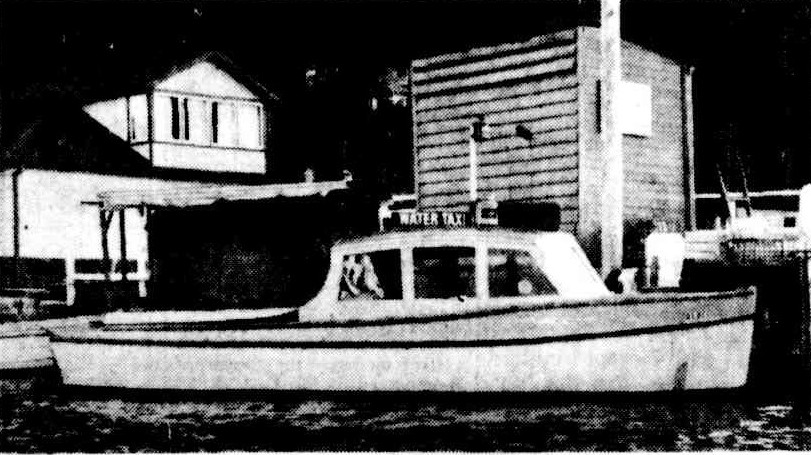
22ft launch, Aldec, which ferried passengers and goods in Pittwater. Father, Son Drowned In Pittwater. (1954, August 11). The Sydney Morning Herald (NSW : 1842 - 1954), p. 1. Retrieved from http://nla.gov.au/nla.news-article18431522
Sydney models Pat Woodley, Michelle Safargy, Jean ' Newington, Peggy Williams and Joan Hirst will take part in a fashion parade to be compered by Chips Rafferty and his wife at the Pasadena Road House on Saturday in aid of the Bill Roberts Benefit Fund. A free ferry ride to Church Point will be supplied by the Port Jackson ferry company for people living at Palm Beach and surrounding Pittwater districts. For inquiries, ring Mrs. Goffage, FA6525. Tickets are 7/6 each. Night and Day (1954, September 8). The Sun (Sydney, NSW : 1910 - 1954), p. 46. Retrieved from http://nla.gov.au/nla.news-article229895009
This is not a photo of that night but of may be close to what happened looked like - and also a hankering back to 'Chips' earlier shearing days as well as his ability to do pretty much anything called for.
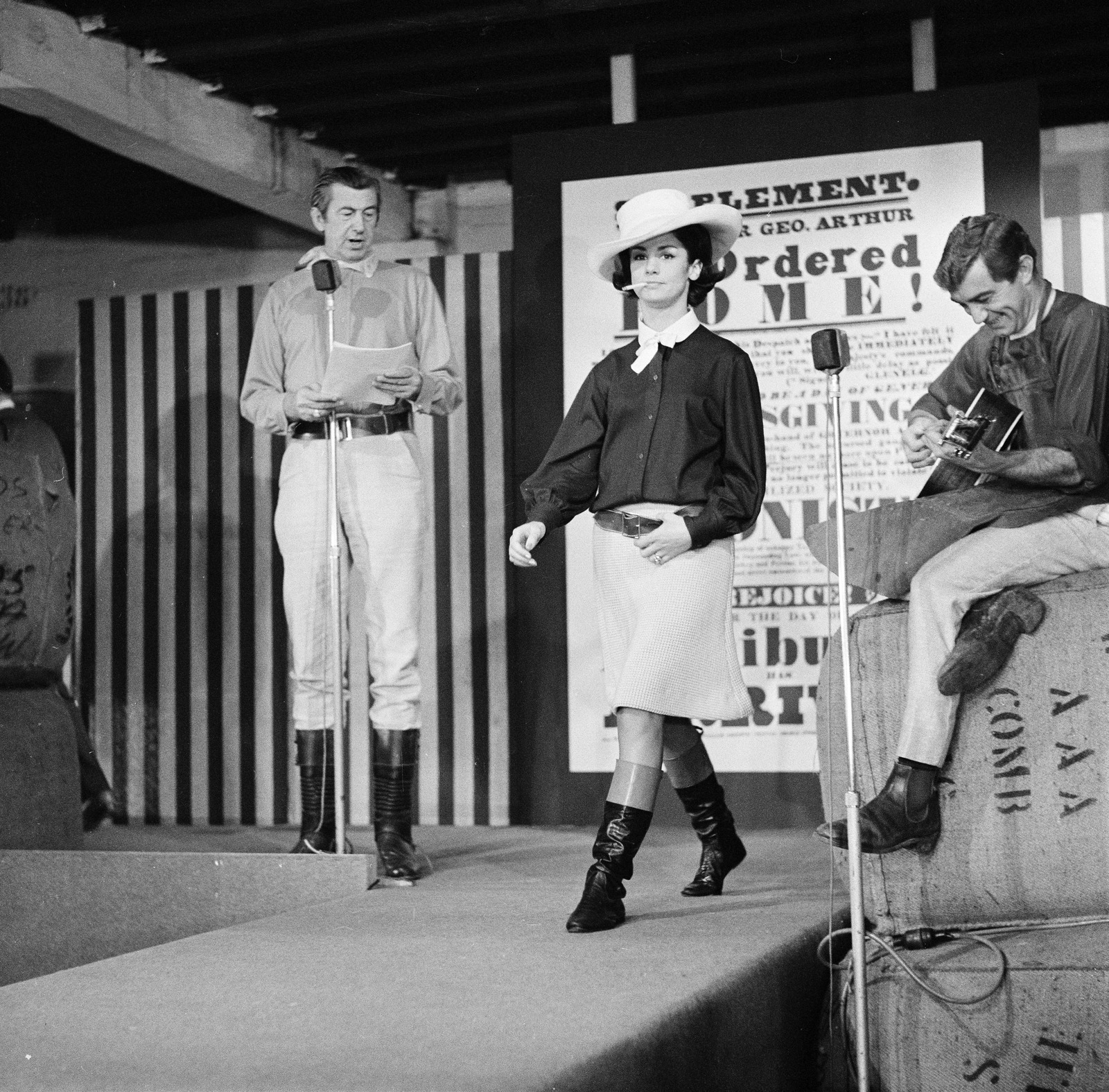
Wool Bureau - Blundens Advertising Sydney Wool Stores, circa 1960. Copyright Henry Talbot, (1920-1999) photographer. Item: FL16304423. courtesy State Library Victoria
John Goffage never lost his willingness to help a mate or stay in touch with his fellow Veterans and do what he could when he could:
"CHIPS" RAFFERTY
COCKTAIL PARTY
FILM star "Chips" Rafferty will act as host at a cocktail party' at the Federation Hall, 166 Phillip Street, on April 30. Well-known radio and stage personalities will serve a "Chips" cocktail to the guests.
Proceeds will go to the T.B. Sailors, Soldiers, and Airmen's Relief Fund. Miss Josephine Marks is president of the committee organising the party. Mrs. Paul B. Nelson (BW5208 or FA5097) is in charge of bookings. "CHIPS" RAFFERTY COCKTAIL PARTY (1947, April 24). The Daily Telegraph (Sydney, NSW : 1931 - 1954), p. 22. Retrieved from http://nla.gov.au/nla.news-article248290198
This 1954 'help' is all the more poignant when you know Quentin lost her own mother just a few weeks before this tragedy:
JAMESON, Martha.—July 4, loving mother of Margaret (Mrs. N. K. Lane), Quentin (Mrs. J. Goffage), and Laurence. Privately interred July 6. Family Notices (1954, July 7). The Sydney Morning Herald (NSW : 1842 - 1954), p. 34. Retrieved from http://nla.gov.au/nla.news-article18424736
Platypus Productions was the company set up in 1953 by Chips, the most prolific producer during the 1950's Lee Robinson, with whom Chips had worked in radio, and cameraman George Heath. They made, in 26 days, ''The Phantom Stockman'', mainly filmed around Uluru (Alice Springs) and which did well in Britain under the title 'Cattle Station''.
The production company became 'Southern International' next year and they set off to film 'King of the Coral Sea' on Thursday Island and Green Island - this too did well here and overseas - and the 'boatshed' they are reported to have first knocked up as accommodation on Lovett Bay became an 11-bed 'shack' for them and their friends and his sisters and brothers:
Strictly Background
Mrs. Chips Rafferty insists that she is "strictly in the background," but even a few; moments' talk with her is sufficient to show, that she plays an important part in her husband's career. She invariably goes on location when he is making a film, and takes what she calls "protective measures" to save him from extra strain or worry. At present Mrs. "Chips" is in Melbourne with her husband for the Australian premier of King of the Coral Sea at the Majestic this evening, she is no stranger to this city. Born in Victoria, she lived at St. Kilda for 18 years. But there are few places in Australia to which she is a stranger as she has visited most corners of the country — from Alice Springs to Green- Island with her husband,, on location and on his personal appearance tours. . At present the Rafferty 2pe is a combination of a flat in King's Cross, Sydney, and a beach house at Church Point, which Mrs. Rafferty describes as "our Shangri-la to which we escape to read through possible film stories; script-write — and even act our scenes for timing." But shortly they will be moving to New Guinea, where Chips Rafferty and his director, Mr. Lee Robinson, will be making a series .of films. Whereas many women might feel apprehensive of transferring from a Sydney flat to a Port Moresby, . bungalow, Mrs. Rafferty, who is full of vitality and is looking forward to starting a new and completely different sort of life. Strictly Background (1954, August 12). The Age (Melbourne, Vic. : 1854 - 1954), p. 7. Retrieved from http://nla.gov.au/nla.news-article205687154
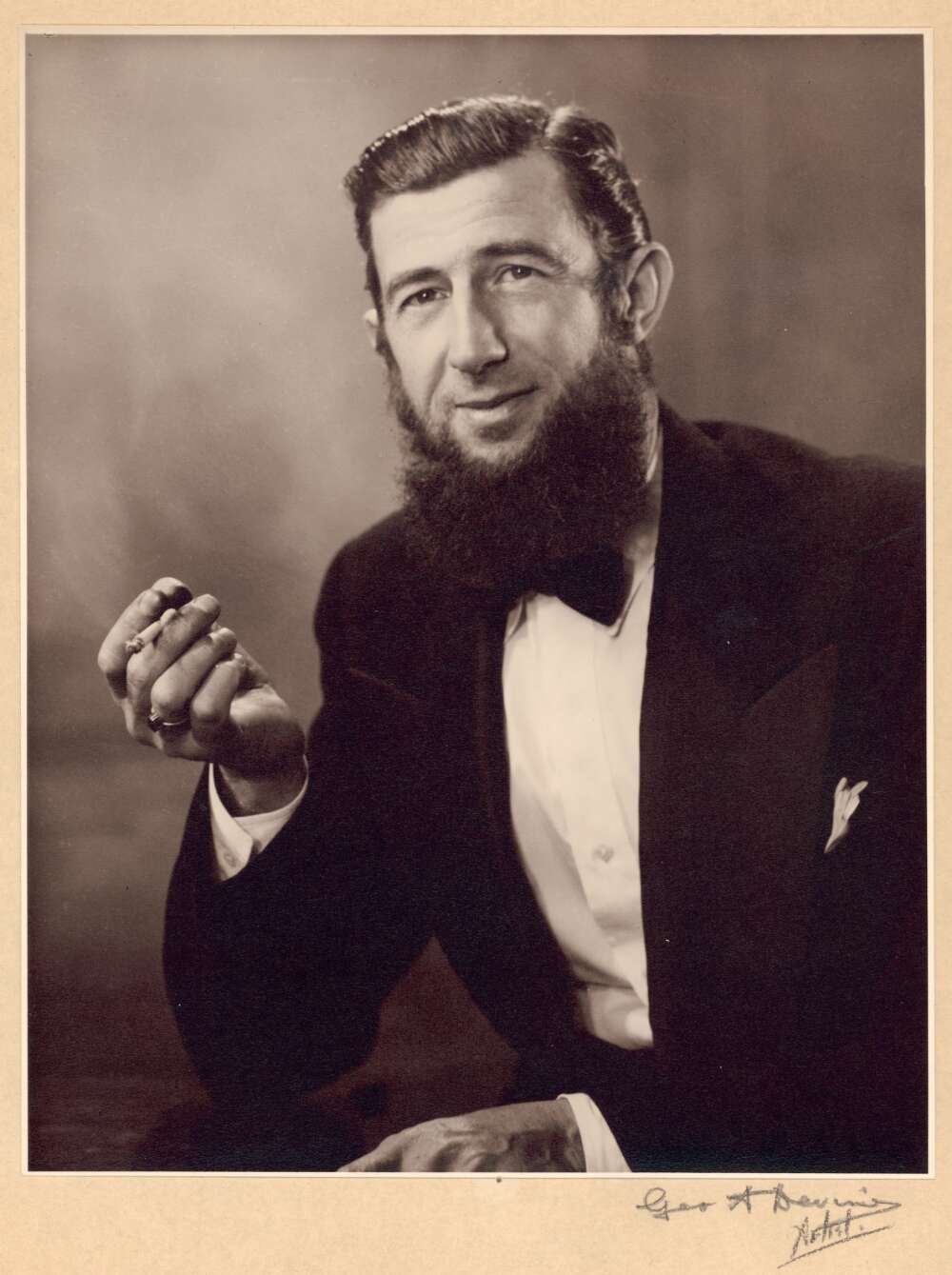
Devine, George A. (1948). Portrait of Chips Rafferty dressed for Eureka Stockade, 1948 Retrieved from http://nla.gov.au/nla.obj-136719563
RETREAT FOR RAFFERTYS - HOUSE FROM AN OLD ROATSHED
By ANNE BRADLEY, staff reporter
Chips Rafferty and his tiny wife, Quentin, retreat from the rush and hustle of the city to their house near Church Point as often as they can, and according to Chips, "It's the only thing that keeps us sane in the madcap film business."
THE house, on the waterfront of Pittwater's Lovett Bay, 20 miles north of Sydney, is accessible only by boat. This gives the Raffertys, whenever they are down there, the feeling that they are completely cut off from the rest of the world.
They listen to the calls of the birds, the jumping of fish, and often see wallabies hopping through their garden at dusk or dawn.
The Rafferty house was a humble boat-shed when they bought it 11 years ago. The boatshed is now a spacious living-room with double doors opening on to a verandah. In fine weather the sun floods through the room all day, and on chilly nights a log fire blazes on the big open hearth.
The Raffertys love to entertain their friends at weekend house-parties, so they have devoted all the upstairs space to bedrooms containing 11 beds, each room with big windows commanding panoramic views of Lovett Bay and Pittwater.
Chips has done most of the remodelling of the house himself. He has built rock walls and stone steps, a long jetty, and a workshop. He has begun work on a rock-enclosed swimming-pool near the jetty, and plans to dump sand on the rocky shore to make a private beach.
At Lovett Bay, Chips and Quentin wear their oldest clothes and spend the days lazing in the sun, fishing, or swimming. At night they often play dominoes, scrabble, or chess. And they always bet on the results.
"We challenge each other to whatever game we play," said Quentin, "or bet on who catches the first and biggest fish. We keep a point score for each competition and play each other for a shilling."
With no electricity supply, they have a generator driven by a kerosene motor to light the house. For cooking they use a small portable stove.
In this out-of-this-world setting, Chips is no longer the film star or producer. Most of his friends call him John, a reminder that he was born John Goffage, in Broken Hill, N.S.W., in 1909. Chips, standing 6ft. 6in. in his socks, is all that people overseas imagine an Australian to be. ...
He prefers to roll his own cigarettes, making them as neatly as any tailor-made; he is often laconic, but never unfriendly; he swears volubly at his small motor-boat — his only means of getting to his house over the water — and never takes it over without a load of beer among the stores.
Quentin, his foil in every way, has one outstanding characteristic — gaiety. Chips, once defining the perfect woman, insisted that gaiety should be her most important characteristic. He also said the perfect woman must be a good cook — and Quentin is, specialising in Chinese dishes.
Whether expensively gowned for a first night, or dressed in her fishing trousers and old jacket, Quentin is forever feminine, with impeccable nail varnish and make-up.
With practically no experience beyond an interest in amateur theatricals, Chips began his film career at the age of 30. He was soon chosen for one of the leading roles in "40,000 Horsemen."
Five years ago he formed Southern Inter-national Films, the company which has suc-cessfully made "King of the Coral Sea," "Walk Into Paradise," and, very recently, "The Stowaway," co-starring Martine Carol..
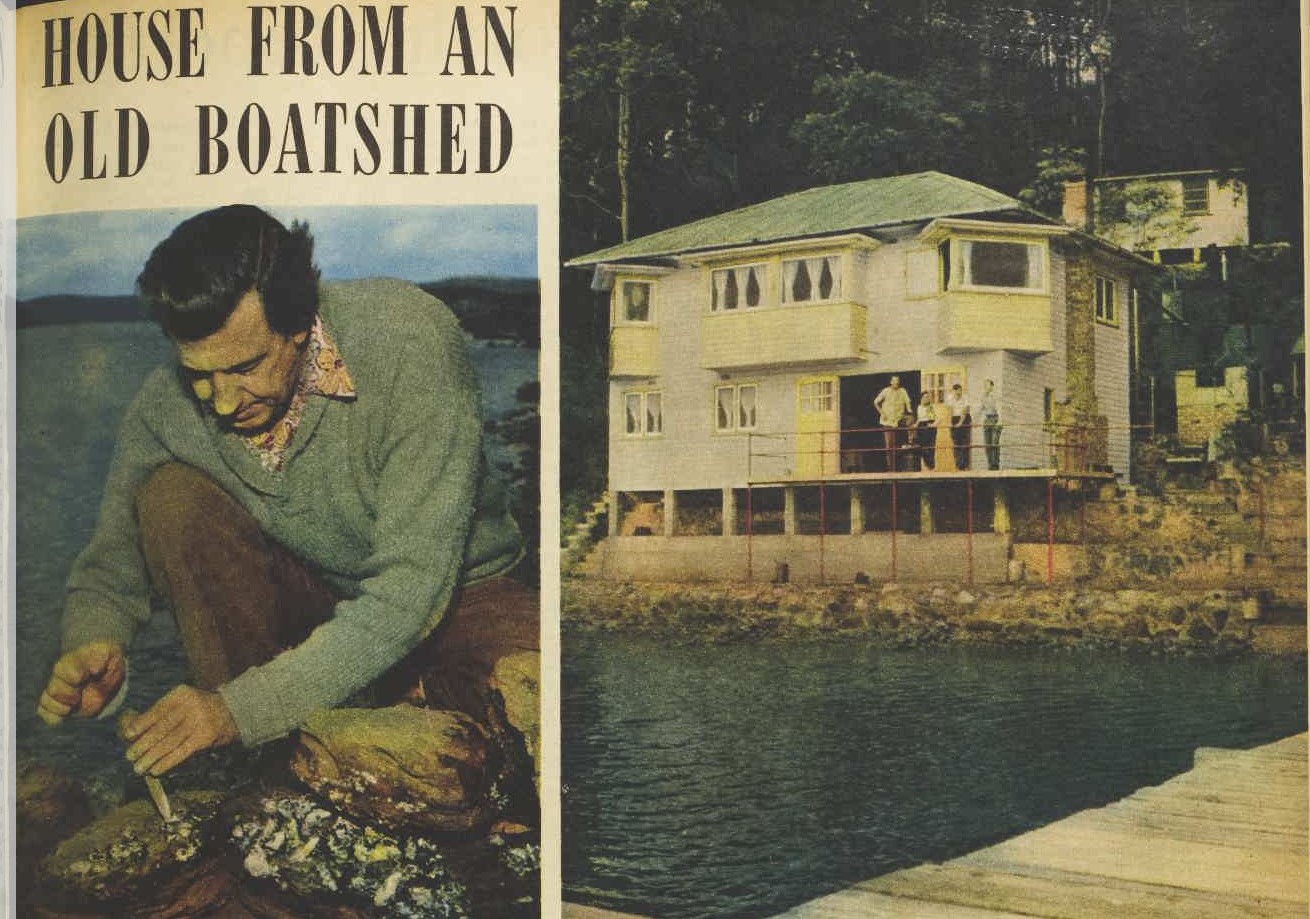
ABOVE: Chips collecting oysters from the rocks right outside his front door. He uses them for one of his favorite dishes — or as bait for his fishing excursions. THE RAFFERTYS and two of their guests admire the view from the verandah outside the living-room of their Lovett Bay home. The pictures are by staff photographer Ron Berg.
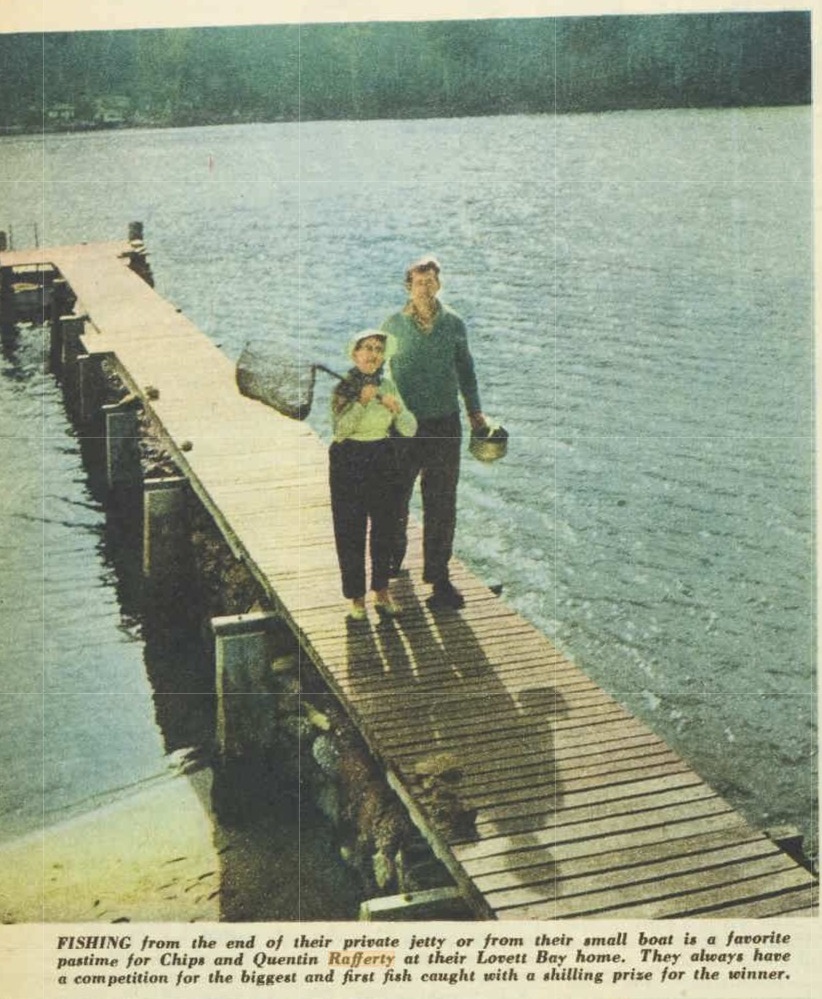
FISHING from the end of their private jetty or from their small boat is a favourite pastime for Chips and Quentin Rafferty at their Lovett Bay home. They always have a competition for the biggest and first fish caught with a shilling prize for the winner.
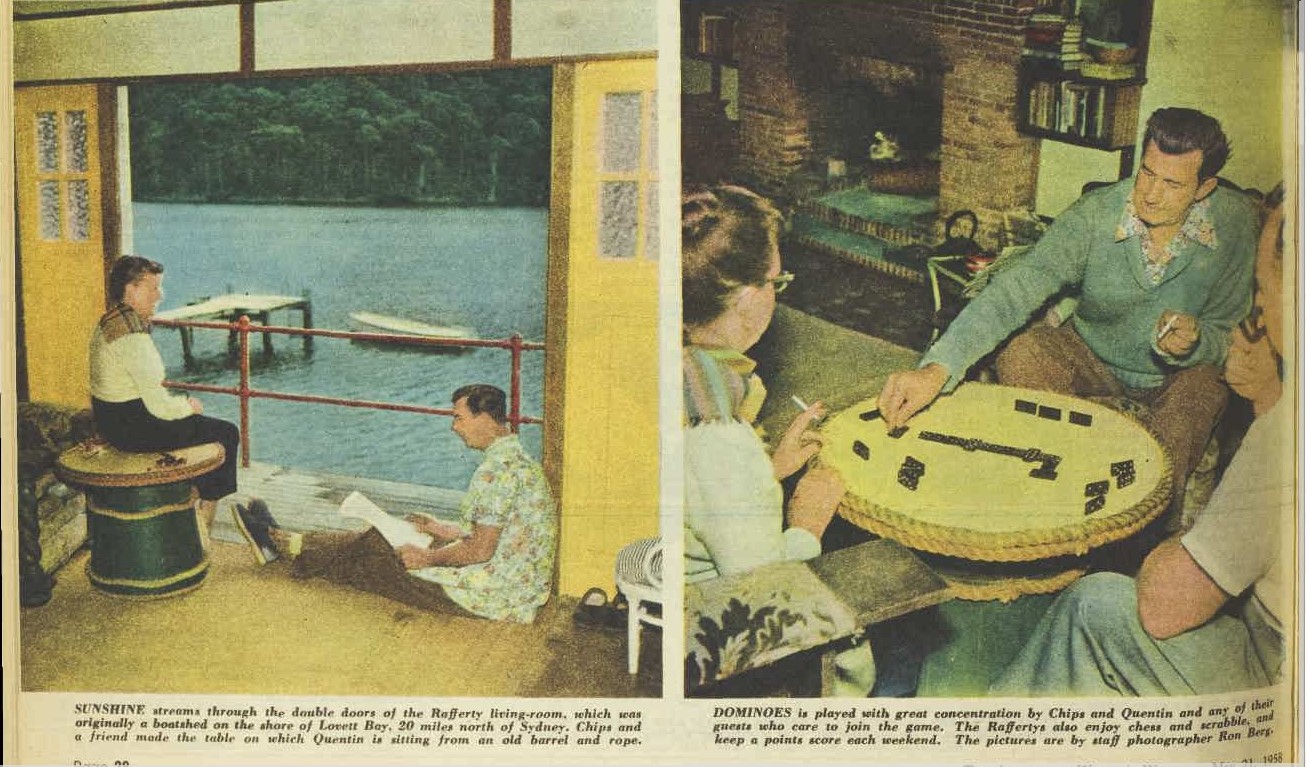
RETREAT FOR RAFFERTYS HOUSE FROM AN OLD BOATSHED (1958, May 21). The Australian Women's Weekly (1933 - 1982), p. 29. Retrieved from http://nla.gov.au/nla.news-article47508024 - More photos and text are available in the article at link
The couple still had a 'place in town' - and were still 'moving around between places, at Bondi at the beginning of 1962 and Vaucluse by year's end.

"Chips" Rafferty, Bondi, 11 January 1962 / photographs by Cec Lynch, Courtesy Mitchell Library, State Library of New South Wales. Chips Rafferty at Southern International Films
It seems that as soon as you go abroad you start dreaming of Australia's sunshine, and former Sydneyite Olita Table-Porter has spent the past 16 years thinking fondly of sunny Sydney. Now living just off fabled Sunset Boulevard in Hollywood with husband Mitch, Olita was so homesick she flew here two months ago to visit old friends and it has rained practically every day. Olita who is secretary of an Australian Wives' Club in Hollywood, has been staying with Chips and Quentin Rafferty at their Vaucluse home. She will sail for the States in Himalaya on June 12 to what, she hopes, will be less disappointing weather. SOCIAL ROUNDABOUT (1963, May 29). The Australian Women's Weekly (1933 - 1982), p. 8. Retrieved from http://nla.gov.au/nla.news-article47510213
.jpg?timestamp=1628988857269)
Chips Rafferty at Vaucluse, 15 October 1962 photographs by Cec Lynch, Courtesy Mitchell Library, State Library of New South Wales.
In the 1960s 'Chips' played parts in a great number of English and US television series including, Emergency-Ward 10 (1964), The Wackiest Ship in the Army (1965) Gunsmoke (1966), Daktari (1966), The Girl from U.N.C.L.E. (1967), Tarzan (1967) and The Monkees, as well as the Elvis Presley movie Double Trouble (1967) and the adventure tale Kona Coast (1968).
Tragically Quentin died May 27th 1964, their wedding anniversary, when he was in England working on Ward 10 and was found in their flat the next day.
Back in Australia he guest-starred in Skippy the Bush Kangaroo, Adventures of the Seaspray (1967), Rita and Wally (1968), Woobinda, Animal Doctor (1970) and Dead Men Running (1971). He also took part in publicity stunts and commercials, showing a lifelong propensity of being aware of how his father's death when his siblings were still quite young impacted on the family and that you must seek or take any work you can get, particularly in the creative industries, although by now, of course, this gentleman who was among those who commenced a purely Australian film industry, was a legend - everyone loved him:.
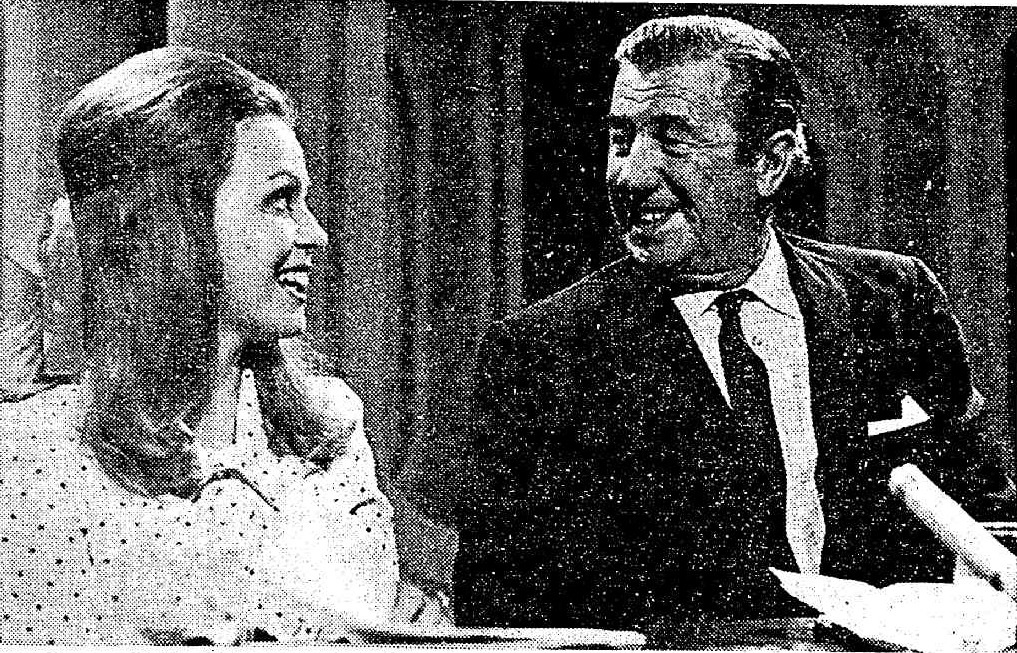
Regular panellist Jacki Weaver talks with special guest star Chips Rafferty during filming of 'Would You Believe', an entertaining series of unlikely stories about Australian people, places and events. The programme is screened on ABC-TV on Monday nights at 8.30pm. Priest is guest in 'Homicide' (1970, February 16). The Canberra Times (ACT : 1926 - 1995), p. 13. Retrieved from http://nla.gov.au/nla.news-article131687341
One promotions 'stunt' example shows his retained a fondness for the place where two of his siblings were born:
'Wagen Train'
NEXT Saturday at 10.15am a team of seven Volkswagens led by "Wagen Master" Chips Rafferty, will pull in to Greg Cusack's in Lonsdale Street on an economy run from Brisbane to Adelaide. A competition open to anyone is being run in connection with the drive.
The person who correctly estimates the average miles per gallon over the whole run will win a new Volkswagen. Entry forms are available from Cusacks.
Amongst the drivers taking part will be motoring journalists Clyde Hodgins of Sydney and Bill Reed of Canberra. The director of the economy run is Mr Max Thomson of Mobil Oil Australia Ltd. Other drivers are from the Victoria Police Motor Sports Club and the VW Club of NSW.
Chips Rafferty is probably Australia's best known film star. His first film was 'Forty Thousand Horsemen', made just before the war, and he has since played in 'The Overlanders', 'Smiley', 'The Sundowners', 'Mutiny on the Bounty' and 'They're a Weird Mob'.
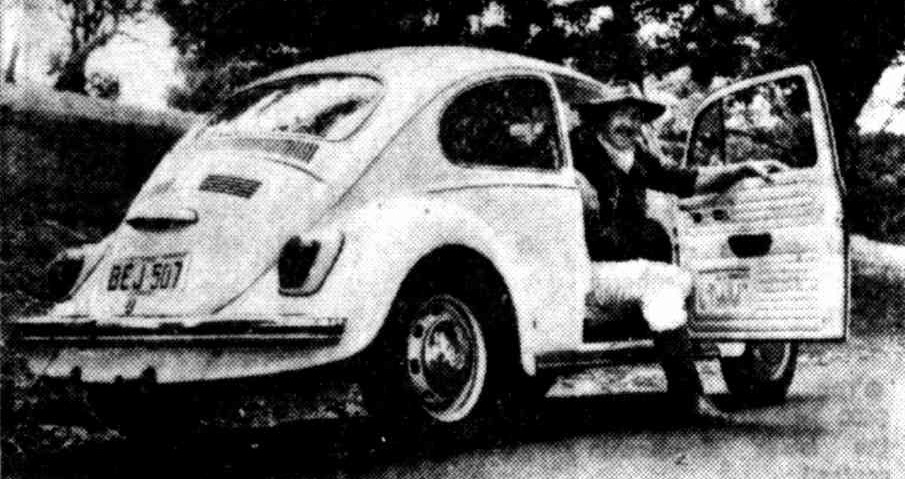
Chips Rafferly in the VW Beetle he is driving in the Brisbane-to Adelaide economy run. 'Wagen Train' (1970, August 18). The Canberra Times (ACT : 1926 - 1995), p. 14. Retrieved from http://nla.gov.au/nla.news-article110337905
His final film role was in 1971’s Wake in Fright, where he played an outback policeman. The movie was filmed mainly in and around his home town of Broken Hill. In a review of the film, a critic praised Rafferty’s performance, writing that he “exudes an unnerving intensity with a deceptively menacing and disturbing performance that ranks among the best of his career.”
In the January 1st New Years Day Honours List of 1971 he had been named an M.B.E., 'For service to the performing arts (Chips Rafferty).'
His final performance was in an episode of the Australian war series Spyforce (1971), the 1971-1973 television series that ran on Channel 9 and was even repeated into the later 1970's. This was filmed in some overseas locations, the old streets of inner Sydney and in the bush at Deep Creek, Narrabeen with an old house on the lagoon used as a production headquarters that was also called into action for some scenes. This final foray also featured Collaroy raised Jack Thompson. According to records about the making of Spyforce, a big talking-point for local residents was the mock-up of an Australian wartime submarine, constructed from wood, fibreglass and metal. Although not built exactly to scale it could look pretty convincing when putt-putting around on the inner lagoon. The model had two outboard motors concealed at the stern to enable it to sail to the various 'battles' - at around three knots....
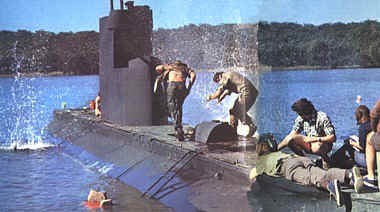
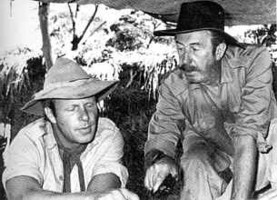
Screengrabs: Filming a scene on board the mock-up submarine on Narrabeen Lagoon and from Episode 20, ‘Reilley’s Army’, was Chips Rafferty’s final role. He is seen here with Jack Thompson
... "Spyforce" has good strong stories; it is well scripted. Episodes have been made in Hong Kong, Macao, Bangkok, Malaysia, and Singapore, but most have been shot at Narrabeen Lakes and at Deep Creek, off Sydney's Wakehurst Parkway. There is a belt of rainforest there that makes remarkably good New Guinea and Asian territory. Indeed, it is so good that the ABC "borrowed" some of the terrain when they shot a recent "Dynasty" episode, called "The Killing Ground," in which an Australian journalist was captured by the Viet Cong. Deep Creek doubled admirably for Viet Cong territory. AUSTRALIA'S OWN SPY SERIES (1971, August 11). The Australian Women's Weekly (1933 - 1982), p. 12. Retrieved from http://nla.gov.au/nla.news-article46452520
One story is told of a phone call Producer Roger Mirams received one day from the Department of the Navy in Canberra: "We have been told that there is a submarine in Narrabeen Lake," said the official, "and that you might be able to shed some light on this matter!"
John 'Chips' Goffage collapsed and died of a heart attack while walking down Billyard Avenue, Elizabeth Bay On May 27th, 1971 at the age of 62. He was on his way to visit a friend.
Newspapers across Australia ran tributes:
Vale Chips Rafferty
Nearly 300 people attended the funeral of well known actor, Chips Rafferty in Sydney on Monday. Chips had collapsed and died while walking to visit a friend. Actors, R.S.L. friends and film and T.V. executives were among the mourners who crowded the chapel at Lane Cove for the service. Towards the end of the service about 40 R.S.L. friends came forward to place poppies on his coffin, Chips Rafferty was the actor's stage name and he was also Flying Officer John Coffage during the war years. He had left instructions for his ashes to be mingled with those of his wife Quentin and scattered over a favourite fishing spot in Lovett Bay which has become known as 'Rafferty's Hole.' Vale Chips Rafferty (1971, June 3). Noosa News (Qld. : 1968 - 1974), p. 3. Retrieved from http://nla.gov.au/nla.news-article260496019
Actor's estate.
SYDNEY, Thursday. — Actor "Chips" Rafferty has left an estate of $116,284 to his two sisters, his brother and a woman friend.
Mr Rafferty, whose real name was John William Pilbean Goffage, collapsed and died of a heart attack in Sydney on May 27 last. He was 62.
Mr Rafferty, a widower, left $10,000 to a friend, Marcia Merle Little, of Evans Road, Elizabeth Bay. Actor's estate (1971, November 5). The Canberra Times (ACT : 1926 - 1995), p. 7. Retrieved from http://nla.gov.au/nla.news-article110685563
On May 12th, 1989 'Chips' appeared on an Australian stamp among those issued to celebrate Australian Stage and Screen legends in recognition of his work in Australian cinema and as The Oxford Companion to Australian Film states of Rafferty as "Australia's most prominent and significant actor of the 1940s–60s".
Many of us who still enjoy his work today didn't think he was 'acting' - he was simply being the self he had grown into and was seen, time and again with those Akubras and khaki, as being in the uniform of the eponymous Australian man who emerged from the post WWI world of Australia and stood as himself and didn't give a damn to kowtow to those who would look down their noses at Australian mateship and was a bridge between the old Australia that looked constantly to Britain and the new Australia, that looked only to itself, acted for itself and spoke for itself - in its own accent (and perhaps with a hankering back to his maternal Irish Rebellion blood) - of a will to not only survive but succeed.
He served his country in the Pacific arena of WWII, he served with everything in him for decades after that conflict. He never really got out of uniform, except to go fishing....
He is with us still by being here with his Quentin in Lovett Bay.
Below is a tape of a candid and informal radio chat from late 1970, as ABC announcer Rod McNeil talks to Long John Goffage, far better known as Chips Rafferty, MBE on the then popular weekly show called ‘Personal Choice’, where Chips reminisces with Rod about many of the interesting times of his life in Australia and around the world, and also selects some of his favourite music and songs to share.
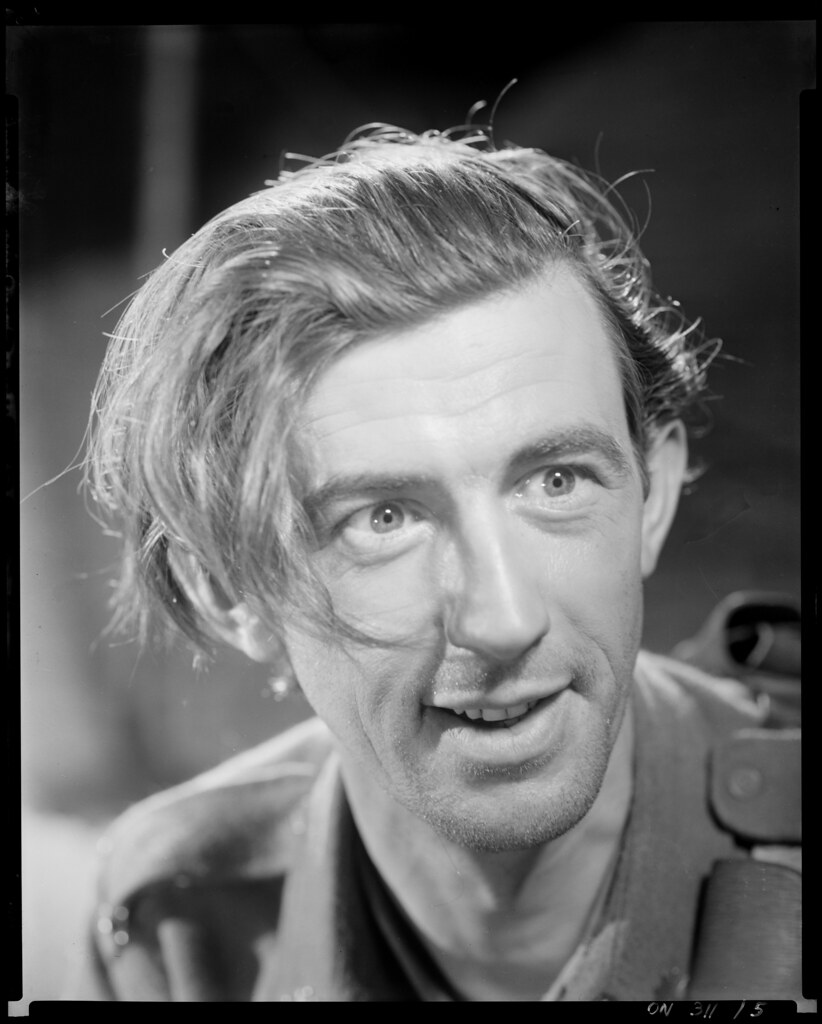
In 40 Thousand Horsemen
References and Extras
- TROVE - National Library of Australia
- Pittwater Summer Houses: Rocky Point and Elvina Bay - A Place Of Holiday Songs and Operas In Ventnor, Fairhaven, Trincomalee and Maritana
- MV Elvina (Falcon)
- GOFFAGE JOHN WILLIAM : Service Number - 36962 : Date of birth - 26 Mar 1909 : Place of birth - BROKEN HILL NSW : Place of enlistment - SYDNEY : Next of Kin - GOFFAGE ELLEN [this is a photocopy of the original record in custody as A9300, GOFFAGE JW] - National Archives of Australia
Although 'Chips' clearly wrote poems and stories, and worked as a journalist, only one item turned up - which is a pity as this is great work:
ORDEAL BY WATER.
Humour and Adventure of a Shearer's Trek.
BY JOHN W. GOFFAGE.
On the Western Plains of Queensland, where space is unlimited and distance and monotony become hazards, travelling by car can be-and in most cases is-an adventure. It is an experience that calls for endurance, both spiritual and physical, and, above all, a sense of humour.
THE overland track between Bierbank Station, on the Charleville-Quilpie line, and Warbreccan Station, 150 miles south-west of Longreach, is about 300 miles long In dry weather the only troubles are dust, flies, punctures, heat, and ennui, and barring a serious break-down the distance is usually covered in from 12 to 16 hours It is when the rains come that the difficulties bristle.
I did the trip with a shearing team in 1930, it took us two weeks! We started from Bier-bank in the chill, windy half-dawn The sky was aglow with an eerie diffused copper coloured light, sure sign of a hot day and a quick, uneventful run to Waibreccan
But this Is indeed the "wilful land' that Dorothea MacKellar knew so well The manager of Bierbank had warned us that heavy rain had fallen at the reach" and we might find some difficulty in getting through, but even then we were totally unprepared for what we encountered. The first 50 miles were speedily, though somnolently, left behind and we were almost within sight of Adavale, a drab, tin shanty town that sprawls in ungainly squalor on the edge of a vast expanse of stunted gidgea when we were stopped by the Blackwater Creek. Stopped? We were literally hurled back in confusion, for the usual meagre trickle had been transformed into a swill of bawling muddy destruction, a hundred yards wide Beyond this was the inevitable bore drain, no longer the pleasant, green-fringcd oasis of drought time, but a hazard almost as bad as the Blackwater. To make matters worse a gully, between the bore drain and the town, had become a river.
On to Bulloa
We managed to get the eight cars into Adavale just before dusk, but it was hard and trying work. First the sumps had to be drained sadly taxing our ingenuity to supply containers for the oil, and the vulnerable parts of the engines had to be wrapped In oily rags, pants, shirts, and even socks. Then we hauled, pushed, and swore the cars one by one, over the three stretches of water to the edge of the town There were 60 men to do it, yes, but we perspired under a February sun and were tormented by I think every fly in Queensland. It was not an easy task. Indeed, most of us were so exhausted that we went to sleep soon after we had eaten, despite the myriads of enormous cockroaches that spoiled in every corner of the ramshackle hotel.
Profiting a little by our experience at the Blackwater we made inquiries about the Bulloa Rivet, a shallow, swiftly running stream, five miles west of the town. It was lucky that we did so otherwise the time to drive there, argue, and then drive back again would have been entirely wasted. The Bulloa was in flood and running a banker, so we spent the day exploring and exploiting the town.
But the Fates must have decided to make a special butt of us on that trip and would not let us be. After tea they inspired someone to suggest that instead of fraternising with the cockroaches we should camp by the Bulloa and thus get an early start next morning. We did, but at 2 o'clock it started to rain, and the resultant rout landed us back in Adavale.
Our next attempt to cross the river was, by comparison with the Blackwater debacle, easy. Queensland rivers can carry water, but they cannot hold it, and the roaring Bulloa was soon almost back to normal Nevertheless, we still had to push the cars across. That night we camped at Jack-in-the-rocks, the only permanent waterhole for 60 miles This oddly named place was at one time the site of an old shanty pub of the type that once Infested the back country, but is now happily almost extinct "Desolate in desolation" and selling a brand of tough liquor, these hostelries were responsible for many a bush tragedy Jack-in-the-rocks was burned to the ground many years ago, but the origin of Its name hinges upon a tale worth repeating.
The story is that a drover, after a long and hectic knocking-down-his-cheque carousal, promptly killed himself. Being the first person to die in that locality the citizens decided to "open" a cemetery. But, although they explored the surrounding country for many a thirsty mile they never found a possible site. Digging but a few inches under the surface soil invariably brought them to solid Ironstone. Even the enthusiasm of the originator of the idea evaporated in the face of such doughty opposition. Eventually they discovered a crevice in an outcrop, into which, with fitting ceremony, poor Jack was lowered, and thus, the place was named Jack-in-the-rocks.
We were now well on our way with the worst of the journey over, so we thought We met with no further setback until we came to the Balcoo River Suspiciously we approached it.
Days of Misery.
The first Intimation that out qualms were well founded came from the cook at Retreat Station, the homestead being a mile or so back from the river. When he saw us coming he called to the few men who were about and they just stood and laughed until the tears came. So we drove down to have a look at the river for ourselves. Ordinarily the Barcoo is a gentle stream that trickles its few inches of clean swept water over pebbles and petrified wood between the towering banks that are typical of all rivers in the black soil country. And those banks are needed, believe me. What we saw was a river two miles wide, fifty feet deep, and singing along at a good ten knots an hour -a seething maelstrom of devastation.
Four days we waited for it to subside-four days of mutton, damper and unsugared tea, four centuries of misery and utter boredom. Then we gave up, and telephoned to Jundah forty miles on to come and pick us up. After seeing the cars into shelter at Retreat we borrowed the station boat-yes, they know the Barcoo-and rowed across, sadly chastened and, as regards some of the party really ill, scurvy in the form of 'Barcoo" rot having asserted its claim.
In Jundah we speedily recovered our health and spirits, though the Thompson River just outside the town was also In flood with two miles of swamp edging the further bank to be negotiated, before we could win through to that by now almost legendary Warbreccan
After the Barcoo, Jundah was civilisation, but we had to go on, for there were ninety thousand sheep waiting to be shorn We contacted Warbreccan to send all available transport to the edge of the swamp. Unfortunately there was only sufficient transport to take half the team, so we balloted for the privilege of riding in the first load and the lucky winners got away, and arrived safely.
The second load was to go early the next morning, but actually did not "make" Warbreccan till three days later, to find that they hadn't seen a drop of rain for two years! But they didn't have long to wait for it after we arrived. ORDEAL BY WATER. (1940, June 1). The Sydney Morning Herald (NSW : 1842 - 1954), p. 11. Retrieved from http://nla.gov.au/nla.news-article17684400
Goffage Family Notes
John Goffage was born in 1859 at Longfleet, (Poole) Dorset, England, United Kingdom. to John Thomas Goffage schoolteacher, and Lucy Ann Dockery, piano teacher.
QLD BDM’s give her death date as 17/06/1903 Mother: Mary Ann Lake, Father/parent: Robert Doebery
The report of the Dunwich Benevolent Asylum for the week ending 20th instant is as follows :-In the asylum at last re-port, 1015 males, 173 females ; since ad-mitted, 3 males, 1 female ; returned from leave, 5 males, 1 female ; total, 1023 males, 175 females ; discharged, 6 males ; died, 4 males, 2 females ; absent on leave, 5 males ; remaining, 1008 males, 173 females. Deaths during the week : …. Lucy Ann Goffage, 78, native of Kent, England ; RACES AT CUNNAMULLA. (1903, June 26). The Brisbane Courier (Qld. : 1864 - 1933), p. 11. Retrieved from http://nla.gov.au/nla.news-article19221382
In the 1871 Census John is with his family and attending school.
John Goffage Head M 36 London, Middlesex
Lucy Ann Goffage Wife F 44 Dartford, Kent
Lucy Charlotte Goffage Daughter F 13 Poole, Dorsetshire
John Goffage Son M 12 Poole, Dorsetshire
George Hogarth Goffage Son M 9 Guilden Morden, Cambridgeshire
Harry Campbell Goffage Son M 9 Guilden Morden, Cambridgeshire
Connel Goffage Son M 3 Ashwell, Hertfordshire
Louisa Webb Servant F 24 Ashwell, Hertfordshire[2]
MARYBOROUGH
[FROM OUR OWN CORRESPONDENT]
THE passengers by the Great Queensland were landed yesterday. The vessel arrived in the Bay on Friday, and it was proposed by the agents to the ship to send down the steamer Queensland on Saturday afternoon, at 4 o'clock, to return with the immigrants on Sunday morning. To this arrangement, however, Mr. Faircloth, the local immigration agent, demurred, as he declared he could not get through his clerical duties in time to return on Sunday morning, and that the vessel was not then at her proper anchorage. He would be prepared to return to town on Monday morning. To detain the steamer until Monday, the A.S.N. agents asked an increase of £90 on their original offer, and as the ship's agents were unwilling to pay for the extra accommodation, the s.s. Queensland left for Brisbane. It was not till Tuesday, or four days after the arrival of the vessel in port, that the passengers were supplied with fresh meat, vegetables, or fruit. The vessel is commanded by Captain Geo. Holden, and the passengers are under the care of Dr. W. H. Maclean, Surgeon-Superintendent ; and Mrs. Gaudin, the matron. She brings 417 souls, who may be classed as follows :— Cabin : Mrs. Holden and child, Misses V. Rowe and Rickards, Messrs. A.A.B. Elliott, Needham, Bridgeman, Welsh and son, Garraway, Aldridge and Goodwin, Mr. Hopton and family, Mr. Goffage (school-master,) and family (7), …. MARYBOROUGH. (1875, November 20 - Saturday). The Telegraph (Brisbane, Qld. : 1872 - 1947), p. 5. Retrieved from http://nla.gov.au/nla.news-article169489569
December 12 Queensland, A.S.N. Co.'s s., 287 tons, Captain F. Brooks, from Rockhampton, Gladstone, Bundaberg, and Maryborough. Passengers: Mrs. Ramsay, infant and servant, Mrs. Goffage, Miss Goffage, Mrs. Murphy, Mrs. Ware, Miss Blackburn, Miss Burkitt, Rev. J. W. Warr, Messrs. J. C, Cooma, J. Kennedy, C. F. Dunn, W. T. Cheeke, W. Glennie, R. Leslie, D. R. Eden, A. Hardcastle, J. Boreham, H. Colls, R. Wishart, H. M. Reeve, G. Grenfell, P. Ramsay, J Myers, J. Wright, Pangbourne, G. J. Stewart, W. Shields, Goffage, J. Goffage, H. C. Goffage, G. Goffage, B. Goffage, Master Terry, and 35 in the steerage. H. O'Reilly, agent. Shipping. (1875, December 13). The Brisbane Courier (Qld. : 1864 - 1933), p. 2. Retrieved from http://nla.gov.au/nla.news-article1385790
Roma Justice.
TO THE EDITOR OF THE. BRISBANE COURIER.
Sir --I beg leave through the columns of your valuable paper to bring the following decision, given by the Police Magistrate of the Roma Bench on the 22nd instant, as an instance of the peculiar ideas of law entertained by that (to quote a letter headed, 'Vindication,'' and signed by a brother J.P., inserted in your issue of the 18th instant), " honest, upright, and painstaking, magistrate, than whom a more able average colonial police magistrate does not exist in the colony or elsewhere."
The facts of the case, are shortly these:--A Mr. Goffage, who has been national school teacher, at Cattle Creek, was appointed, by the Government to the Warwick district, and in order to remove his family he borrowed or hired one of Cobb and Co.'s coaches to bring his belongings in from Cattle Creek. A Mr. Copley, a freeholder, who, holds a deed of grant from the Crown, has an. enclosed paddock close to the school-house and residence of Mr. Goffage. There is a public road running round Mr. Copley's paddock to the schoolmaster's residence.
Mr. Goffage, however, had some scruples about using the plain track, and judging it safer and more expeditious, we may suppose, to make a road for himself, deliberately enters Mr. Copley's paddock and takes down part of his fence (not deeming the slip-rails a few yards further off big enough to admit a man of his importance), takes the coach through the paddock opposite to his residence, puts his family on board, and returns the same way and in the act of taking down Copley's fence to allow the coach to go through, he is caught by Mr. Copley, who asks him what he means by tearing down his fence. Mr. Goffage denies that he is tearing down his fence, though caught in the act ; and when asked to give the name of the man driving the coach, he tells Mr. Copley, in reward for his inquisitiveness, to "go and find out," and dares Mr. Copley to summon him (Goffage).
Mr. Copley, therefore, summoned him under the 1st section of the Enclosed Land Protection Act, 18 Vic, No. 27, for "entering without law-ful excuse, and without the consent: of the owner," on his (Mr. Copley's) land. The evidence given on oath proved that the complainant saw defendant in his paddock taking down his rails, and detailed the conversation, the sub-stance of which h given above. Complainant did not see defendant enter the paddock, but saw him in it committing a trespass. In cross examination it was elicited that defendant was in the coach, and being driven along through the paddock, when Copley first saw him. Complainant deposed to seeing him on the ground taking down the fence (and this was not contradicted). It was held by the Police Magistrate that the fact of his (defendant) being in the paddock, and being driven through by another person, was a " lawful excuse " for being in the paddock; and he, further specially ruled when it was put to him by complainant's attorney, ''that the unlawful act of one party, viz., the driver, justified the trespass complained of through defendant's being in the paddock without lawful excuse, and without the consent of the owner."
No defence of right of way was set up, the only defence being that defendant being driven through by a third party, was justified in the trespass he committed. It was held that the proper person to sue was the driver, and no one else. The complainant was therefore mulcted in £2 2s, professional costs. Such is the law as it obtains from the Roma Bench. I trust the Government may in their next appointment send someone who has no knowledge of law (if such be the law), but who has some ideas of the first principles of justice.
I leave the public to judge whether the encomiums passed upon him by his brother magistrate on another occasion--viz., a "Vindication " appearing in your issue of the 18th instant are borne out by the above decision. ---Yours &c.,
Roma, February 22 JUSTITIA.
[If the depositions forwarded to us contain all the evidence taken in this case, we have. no hesitation in saying that a gross miscarriage of justice has taken place. The driver of the coach being hired to drive the defendant was his servant for the time being, and an employer is liable for the acts of his servant performed by his direction or under his super-vision. The evidence shows, however, that Mr. Goffage himself committed the trespass complained of by taking down the fence to allow the passage of the coach. A more striking in-, stance of perversion of law and disregard of justice than is given in this decision it would be hard to imagine. However, when we, lately ex-pressed a somewhat unfavorable opinion of the quality of justice administered in trespass cases by country benches, we called forth so many remonstrances from our Roma friends that we
suppose they are satisfied with their present supply. If so, we have no desire to render them discontented ; but if we were in Mr. Copley's place we would bring this case before the Attorney-General, and if no redress could be got from him, before Parliament itself.--Ed. B.C.] Roma Justice. (1878, March 27). The Brisbane Courier (Qld. : 1864 - 1933), p. 5. Retrieved from http://nla.gov.au/nla.news-article1370929
SANDY CREEK STATE SCHOOL.-It is notified in Saturday's Gazette that Mr. John Goffage has been transferred to the position of head teacher of the State school at Sandy Creek. Mr. Goffage entered upon his duties at Sandy Creek yesterday. LOCAL AND GENERAL NEWS. (1895, April 2). Warwick Argus (Qld. : 1879 - 1901), p. 2. Retrieved from http://nla.gov.au/nla.news-article76649320
TECHNICAL COLLEGE EXAMINATION.
We have great pleasure in stating that Miss L. C. Goffage, who attained 72'5 for advanced cookery at the Technical College, Brisbane, is the daughter of Mr Jno. Goffage, a gentleman well known in this district. TECHNICAL COLLEGE EXAMINATION. (1900, October 29). Darling Downs Gazette (Qld. : 1881 - 1922), p. 2. Retrieved from http://nla.gov.au/nla.news-article185591185
Matron Retires.
TWENTY-THREE years of experience in dealing with girls and young women had impressed a conviction of their excellent qualities on Miss L.C. Goffage, matron of the Lady Musgrave Lodge, who will retire from that position at the end of this month. Girls of today, said Miss Goffage in an interview, are much the same as they always were, the changes that are so much criticised being merely on the sur-face. Greater freedom, she thinks, has taught the modern girl to be more independent and self-reliant, but as a rule she can be trusted to use her freedom wisely, and where there are some who are not so reliable there will generally be found others of good character who will try to keep them in order.
Miss Goffage's experience as matron of the lodge has brought her into contact with many different types, from the wives and sweethearts of soldiers, who made the Lady Musgrave Lodge their home for a time after coming to Australia to join their men during and after the war, to the emigrant girls who have been glad to avail themselves of its hospitable shelter while awaiting a position in their new land, and to the Australian-born girls, capable and independent, who are either in regular positions or are travelling from one centre to another.
Miss Goffage is English by birth, and came to Australia as a child with her parents. She has lived for various periods in Roma, Gympie, and. Toowoomba before taking up her present position, and during her term of office as matron she has been guide, philosopher, and friend to girls and women of all ages, from 17 to maturity, and even old age.
Many of the girls, who came to the lodge as immigrants, and have since married and settled down in their adopted country, visit her regularly, and make her their confidante and adviser. Her duties as matron have included the charge of all internal arrangements, servants and stores, and this, in a home which houses an average of about 35, and at its maximum can accommodate nearly 50, is no small task, but she has the support and assistance of an efficient and energetic committee. During the time that Miss Goffage has been matron the lodge has been considerably enlarged, and its comfort increased, and it is free of debt, a fact that is gratifying to committee and matron alike. After her retirement on January 31 Miss Goffage intends to maintain her active interest in the Girls' Friendly Society, for which she is immigration secretary, and representative on the New Settlers' League, also in the National Council of Women and the Victoria League, of both of which she is a member. Matron Retires. (1933, January 26). The Queenslander (Brisbane, Qld. : 1866 - 1939), p. 33. Retrieved from http://nla.gov.au/nla.news-article23265415
ECHO OF 1875.
THE GREAT QUEENSLAND.
The three-masted vessel, the Great Queensland, left the East India Docks in the early part of August, 1875, Captain Holden being the master (writes Mr. Hubert F. Barker, of Tivoli). After a long and tedious journey of a somewhat uneventful character the ship arrived in
Hervey Bay late in November of the same year. A tremendous storm was experienced when rounding the Cape. One passenger (then a boy of 10) said : ''I did not know, in my youthful innocence, how bad the storm was, but remember seeing in the dim night light down below some men kneeling down and saying their prayers, which struck me as being a most novel performance." I presume he means the earnestness with which they offered up their supplications. In Hervey Bay the sailors mutinied and refused duty.
This was afterwards ascertained to be a put-up job. The seamen simply desired to get out of the oversea service and enter the coastal steamship line - a much more preferable job - and to attain their desires they risked a few months' imprisonment -- and got-it !
MANACLED TO A CHAIN.
The abovementioned passenger, speaking of this, said-; "Constables came aboard and arrested them: I remember them passing by me, manacled up to a chain. Personally I was very indignant, as I regarded them all as 'heroes' of the deepestdye." In Hervey Bay, Mr. R. B. Sheridan (afterwards M.L.A. for Maryborough, and Postmaster-General) came aboard as
visiting magistrate, and lined the passengers up to inspect them generally, and to receive complaints, if any. One of the first things, Mr. Peter Airey, (then a boy - and a passenger with his parents) ….
Mr. Goffage conducted a school for the benefit of the youngsters on the ship. Mr. Goffage was teacher for many years under the Queensland Department and at the time of his death was, I believe, in charge of the Parkhurst School, near Rockhampton. The photograph reproduced in to-day's "Courier" was made from an old faded silver print lent to me, many years ago, by Mr. C. R. Morton. ECHO OF 1875. (1925, July 23). The Brisbane Courier (Qld. : 1864 - 1933), p. 13. Retrieved from http://nla.gov.au/nla.news-article20945400
GOFFAGE.—On 1st August, 1921, Mr. John Goffage, at his residence, Lamington Estate, Toowoomba, in his 88th year. Family Notices (1921, August 13). The Brisbane Courier (Qld. : 1864 - 1933), p. 6. Retrieved from http://nla.gov.au/nla.news-article20501135 - born 1833
FUNERAL NOTICES.
FUNERAL NOTICE.
GOFFAGE.— The Friends of the deceased, Mr. JOHN GOFFAGE, are respectfully invited to attend his Funeral, which will move from his late residence, Meibusch street, THIS DAY, at 2 o'clock for the Toowoomba Cemetery.
By request, no flowers.
T. S. BURSTOW, Undertaker.
DARLING DOWNS GAZETTE.
TUESDAY, AUGUST 2, 1921. Family Notices (1921, August 2). Darling Downs Gazette (Qld. : 1881 - 1922), p. 4. Retrieved from http://nla.gov.au/nla.news-article182752428
TRANSMISSION BY DEATH.
Real Property Acts of 1861 and 1877.
NOTICE is hereby given, that application has. been made for the Registration of Transmission of Title to the Lands hereinafter mentioned. Particulars of such application are
given below,' and any person desiring to oppose must do so by lodging a caveat on .or-before the day specified at the Office of the "Registrar of Titles, in -Brisbane.
Name of deceased Proprietor. John Goffage, late of Toowoomba, retired School teacher.
Date of Death: 1921, August 1.
Name of Claimant: Lucy Charlotte Goffage, of Brisbane, Spinster, as Devisee in Trust.
Description and Situation of Land : Allotment 1 of Section 9, Town of Hodgson.
Estate claimed to be transmitted: Fee simple.
Particulars of Will or otherwise: Will dated 30th October, 1916.
Date within which Caveat may be lodged: 1921, 29th November.
F.J. BRADFIELD, Registrar of Titles.
Registrar of Titles' Office,
Brisbane, 22nd October, 1021.
WONDERLEY & HALL, Solicitors
for Applicant, Ruthven-street, Toowoomba. Advertising (1921, October 26). Western Star and Roma Advertiser (Toowoomba, Qld. : 1875 - 1948), p. 4. Retrieved from http://nla.gov.au/nla.news-article98069669
John William Goffage and family notes:
John Goffage was born in January 1859 at Longfleet, (Poole) Dorset, England, United Kingdom. He was the son of John Goffage and Lucy Ann Goffage (born Dockery) .
John senior was born circa 1834, in Shoreditch, Middlesex, England. Lucy was born on April 2 1825, in Dartford, Kent, England.
John was baptized in 1859. He had 9 siblings.
GOFFAGE — JOYCE. — On the 20th March, at Immaculate Conception Church, Glenferrie, John Goffage, of Broken Hill, to Violet Maude Eyidth Joyce, only daughter of Alice and the late William Joyce, of Kew. Other papers copy. Family Notices (1908, April 4). The Age (Melbourne, Vic. : 1854 - 1954), p. 7. Retrieved from http://nla.gov.au/nla.news-article196113001
The popular and indefatigable secretary of the L.V.R.C., Mr. J. Goffage, has recently returned with his bride from a honeymoon trip to Sydney and Melbourne. Mr. Goffage was married on March 20, at the Church of the Immaculate Conception, Glenferrie, to Miss Violet Maude Eydith Joyce, only daughter of the late William Joyce, of Kew. WOOLEN MILLS. (1908, April 11). Barrier Miner (Broken Hill, NSW : 1888 - 1954), p. 4. Retrieved from http://nla.gov.au/nla.news-article45024171
NSW BDM’s: registered births
GOFFAGE JOYCE P 13723/1911 JOHN VIOLET M BROKEN HILL
GOFFAGE CHARLES F 13199/1919 JOHN VIOLET M HURSTVILLE
GOFFAGE JOHN W P 12485/1909 JOHN VIOLET M E BROKEN HILL
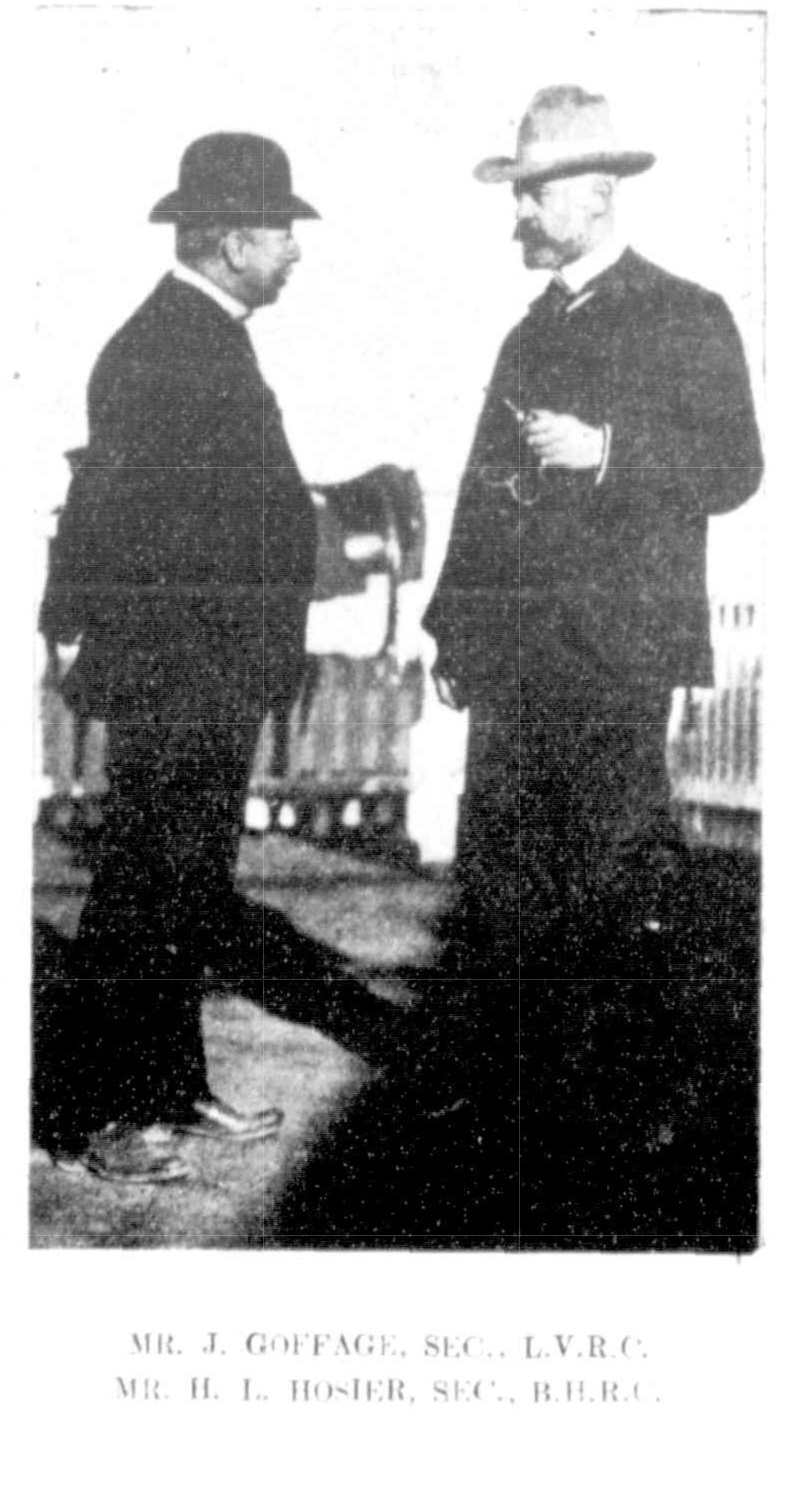
BROKEN HILL RACES. No title (1908, August 1). Observer (Adelaide, SA : 1905 - 1931), p. 32. Retrieved from http://nla.gov.au/nla.news-article164112901
PROPOSED SEND-OFF TO MR. GOFFAGE.
A dinner and purse of sovereigns, as a send-off to Mr. J. Goffage who is shortly leaving Broken Hill for Adelaide to take up the duties as secretary of the Tattersall's Racing Club, Adelaide, will be given by the L.V.R.C. The Licensed Victuallers' Association will take similar action. The date has not yet been fixed. PROPOSED SEND-OFF TO MR. GOFFAGE. (1911, March 25). Barrier Miner (Broken Hill, NSW : 1888 - 1954), p. 6. Retrieved from http://nla.gov.au/nla.news-article45133072
BIRTHS.
GOFFAGE. —On the 19th June, at Bankside, Torrensville, the wife of J. Goffage— a son. Family Notices (1912, June 24). The Register (Adelaide, SA : 1901 - 1929), p. 6. Retrieved from http://nla.gov.au/nla.news-article59065814
JACK GOFFAGE.
Here we have the new secretary of Tattersall's Club, and a right good secretary, too. In fact, not a better is to be found inside or outside the boundaries of the Old Square Mile.. Jack made a name for himself as secretary of the L.V. Racing Club at Broken Hill, making that club a power in the land, besides being universally esteemed by all whom he came in contact with. So great was his fame as a secretary and organiser that it travelled down south, and Tatt's committee made no bloomer when they snapped him. Since he has had charge of Tatt's Club the rooms have been transformed into a club, whilst the horse-racing part of the institution has flourished by leaps and bounds under his masterly supervision. A good sport and hard grafter, genial Jack has made a host of admirers since he settled down in Adelaide. and we hope lie will always remain with us, for he is too good a sort to let transfer his labors, to fresh folds. JACK GOFFAGE. (1912, July 6). Sport (Adelaide, SA : 1911 - 1948), p. 3. Retrieved from http://nla.gov.au/nla.news-article215844963
HOTEL TRANSFERRED.
The license of the Court House Hotel, Lord's Place, was yesterday transferred from James Austin to J. Goffage, who formerly conducted the Oriental Hotel, in the same locality. HOTEL TRANSFERRED. (1916, November 8). Leader (Orange, NSW : 1899 - 1945), p. 1. Retrieved from http://nla.gov.au/nla.news-article117817110
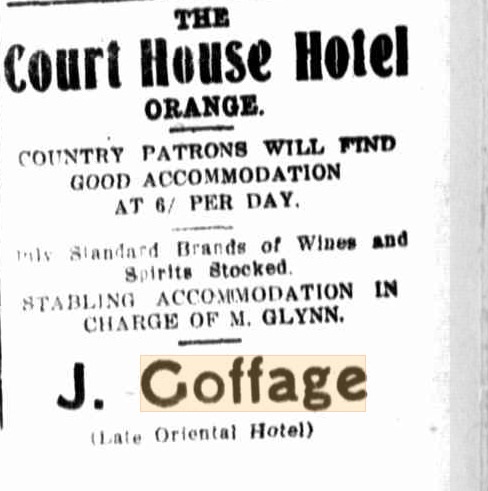
Advertising (1918, January 25). Leader (Orange, NSW : 1899 - 1945), p. 3. Retrieved from http://nla.gov.au/nla.news-article100957718
Private Norman Power, better known as "Romeo," who prior to enlisting was temporarily employed at the railway and about town, writes to this office from France asking us to publicly thank Mrs. W. Milne and Messrs J. Goffage and H. Larance for their many kindnesses to him during his residence in Orange. He says he feels proud to be able to fight for such generous people. PERSONAL. (1918, July 15). Leader (Orange, NSW : 1899 - 1945), p. 1. Retrieved from http://nla.gov.au/nla.news-article117845974
Mr. J. Goffage, the organiser for the Nationalist Party at the Mudgee end of the Wammerawa electorate, has, his good work well done, returned to Sydney. The Nationalists were exceedingly fortunate in securing as their organiser for this end a gentleman of the experience, energy and capacity of Mr. Goffage, and one who makes himself wherever he goes as popular (and as deservedly popular as he does). He has a big record of good work behind him. Mr. Goffage has probably few superior as an authority in the sport of racing.
He was for many years secretary of the Broken Hill Licensed Victuallers Racing Club, and afterwards was secretary of Tattersall's Club in Adelaide, which made great strides under his able and popular direction. Mr. Goffage knows at least as much about mining as he does about horse racing. He had a large share broking business in Broken Hill, and is still the honest worker to the advantage of many clients, and incidentally, of course, to his own. Mr. Goffage is interested in what he regards as some very promising reefing propositions at and about Gundagai. And it is to Gundagai that he proposes to take himself after a short rest in Sydney, greatly needed after his heavy electioneering work in the Wammerawa. He will carry with him to Gundagai, and everywhere else that he may go, heaps of the best wishes from scores of old and new friends. Local Brevities (1920, March 25). Mudgee Guardian and North-Western Representative (NSW : 1890 - 1954), p. 9. Retrieved from http://nla.gov.au/nla.news-article157046147
GOFFAGE.—In loving memory of John Cottage departed this life March 22, 1925. Inserted by his loving wife and family. Family Notices (1926, March 22). The Sydney Morning Herald (NSW : 1842 - 1954), p. 8. Retrieved from http://nla.gov.au/nla.news-article28063060
Parramatta -… John William Goffage, Herbert John Lawrence, Leslie William Sheridan … EXAMINATIONS. (1925, December 31). The Sydney Morning Herald (NSW : 1842 - 1954), p. 4. Retrieved from http://nla.gov.au/nla.news-article16270807
BROKEN HILL RACES AND TRADES UNIONS.
From J. Goffage (Secretary of the Broken Hill Licensed Victuallers' Racing Club):— 'I attach a cutting from The Register of October 20, relative to boycotting my club's meeting on November 3. From the best information obtainable I ' know that the unions have no intention of hampering this club in any way; on the contrary, I believe they are desirous of inducing every person who can possibly get away from business or employment to patronise the meeting. So far as local nominations are concerned they compare favourably with previous off meetings. The discrepancy in the total of our entries is caused by the neglect of Adelaide, owners to favour us with the usual number of nominations. BROKEN HILL RACE AND TRADES UNIONS. (1909, October 25). The Register (Adelaide, SA : 1901 - 1929), p. 10. Retrieved from http://nla.gov.au/nla.news-article58289054
MR. GOFFAGE'S NEW APPOINTMENT.
"Wakeful," writing of the appointment of Mr. J. Goffage, to the position of secretary of the S.A. Tattersall's Racing Club, says:- As secretary of S.A. Tattersall's Club, besides the inside work incidental to the work of the rooms, he will have the control of about half a dozen big race meetings a year, and if he is not as successful with them as he has been with his race gatherings at the Hill, his friends will be much surprised. MR. GOFFAGE'S NEW APPOINTMENT. (1911, March 24). Barrier Miner (Broken Hill, NSW : 1888 - 1954), p. 3. Retrieved from http://nla.gov.au/nla.news-article45143934
JOYCE.—April 30, 1928, at the Royal Prince Alfred Hospital, Alice May Joyce, widow of the late William J. Joyce, late of Victoria, and beloved mother of Mrs. V. Goffage, and sister of Mrs. Dickson, of Westmead. Family Notices (1928, May 1). The Sydney Morning Herald (NSW : 1842 - 1954), p. 10. Retrieved from http://nla.gov.au/nla.news-article16461171
Miss Joyce Goffage (Sydney), who has been spending some weeks as the guest of Miss Meg Goffage at East Brisbane, has returned to Sydney. A Few Lines to Say (1938, January 11). The Courier-Mail (Brisbane, Qld. : 1933 - 1954), p. 27. Retrieved from http://nla.gov.au/nla.news-article39743499
The Irish was a long way back
To lanky, temporarily-bearded Chips Rafferty, star of "The Ovcrlanders" film, came a letter from County Donegal, Eire, this week.
It read:
"Dear Sir, I saw where you are appearing in a film, . 'The Over-landers,' at the Theatre Royal, Dublin.
"I was very interested to see you having the name of Rafferty, a name I bear myself, it is a very old Irish name and anyone possessing it can say truthfully that they are Irish to the backbone.
"I hope your name is really Rafferty and that you can claim Ireland as your birthplace, or at least can claim Irish parentage.
"I could give you a very interesting account of the name of Rafferty which would make you still prouder to bear the name.
"However, good-luck to you always.
"Sergeant Patrick Rafferty."
Chips would have to break the sad news to the sergeant: Rafferty was only his stage name. His real name was John William Pilbeam Goffage, but his great-great-grandfather, on the maternal side, was born in Ireland. Blackbutts were his bread and butter (1947, April 13). The Sun (Sydney, NSW : 1910 - 1954), p. 4 (FACT Supplement). Retrieved from http://nla.gov.au/nla.news-article228980527